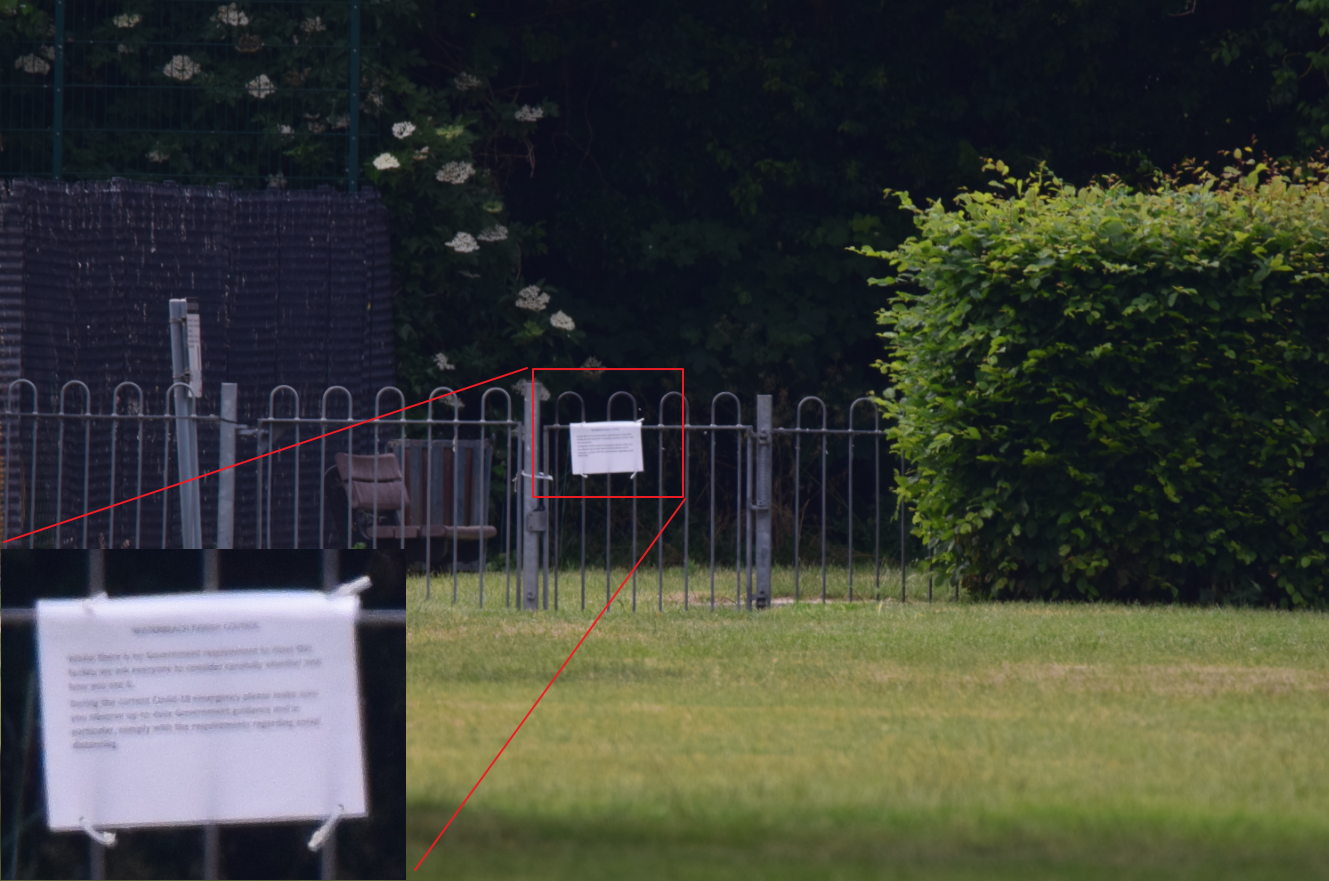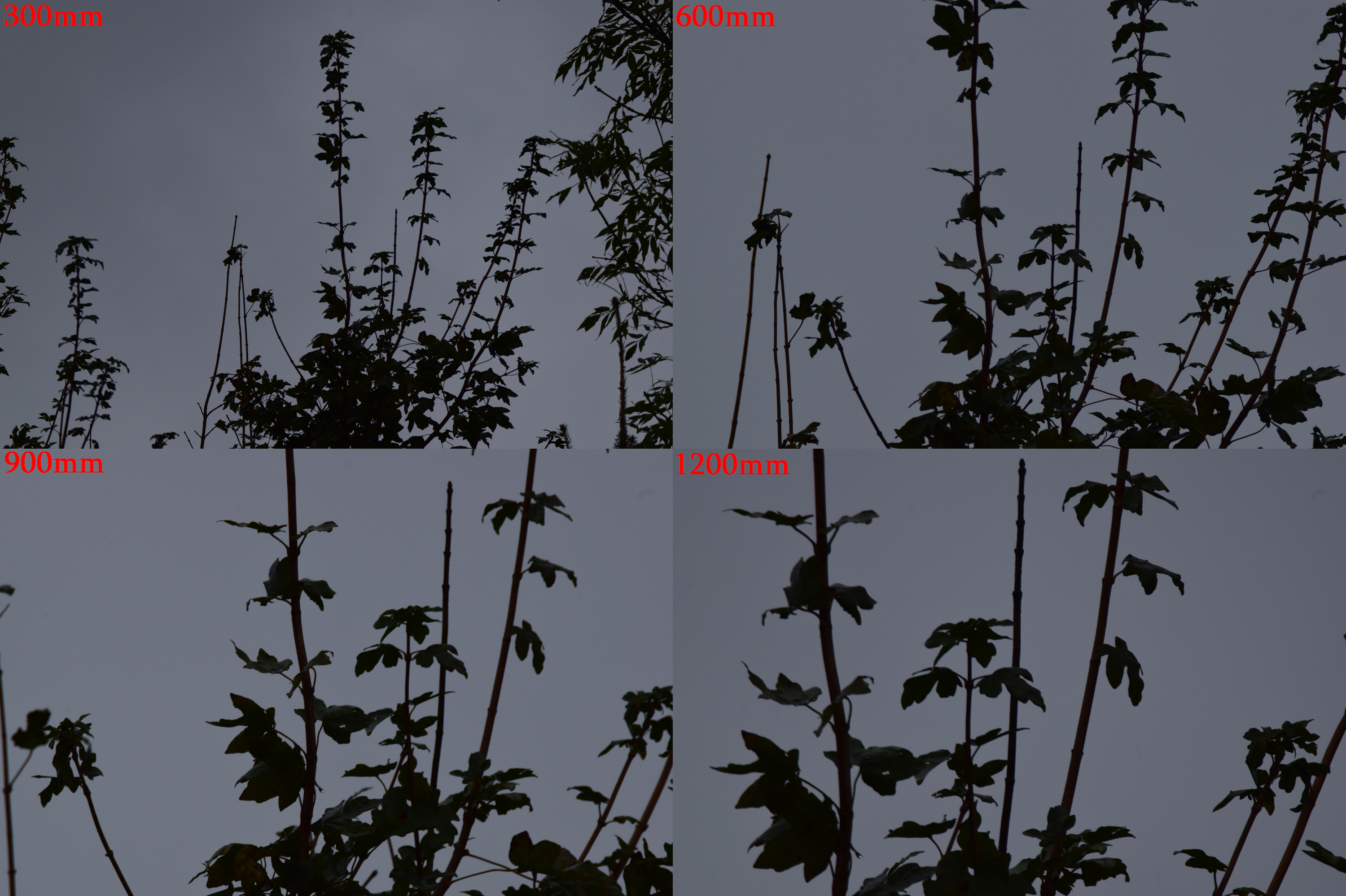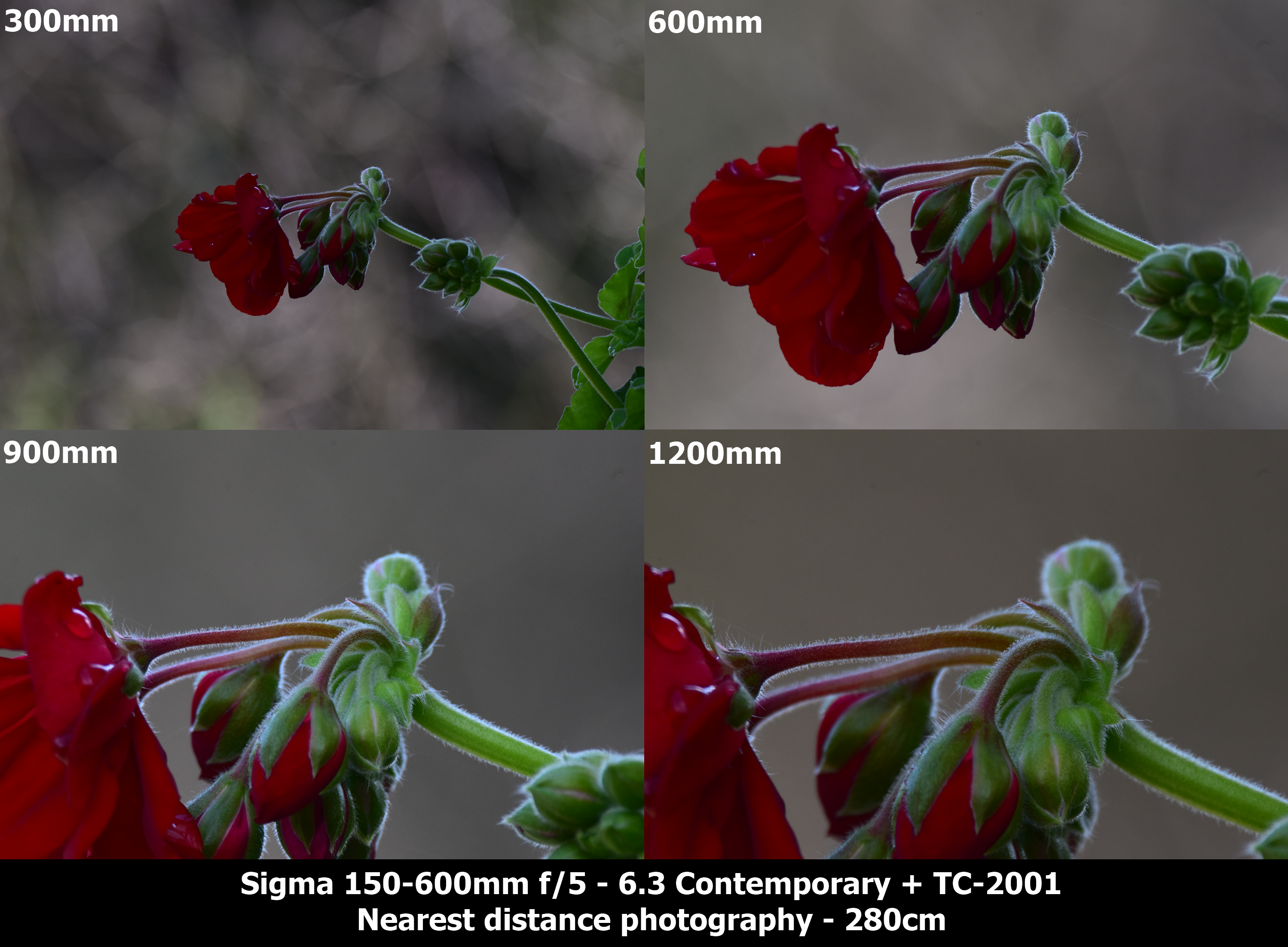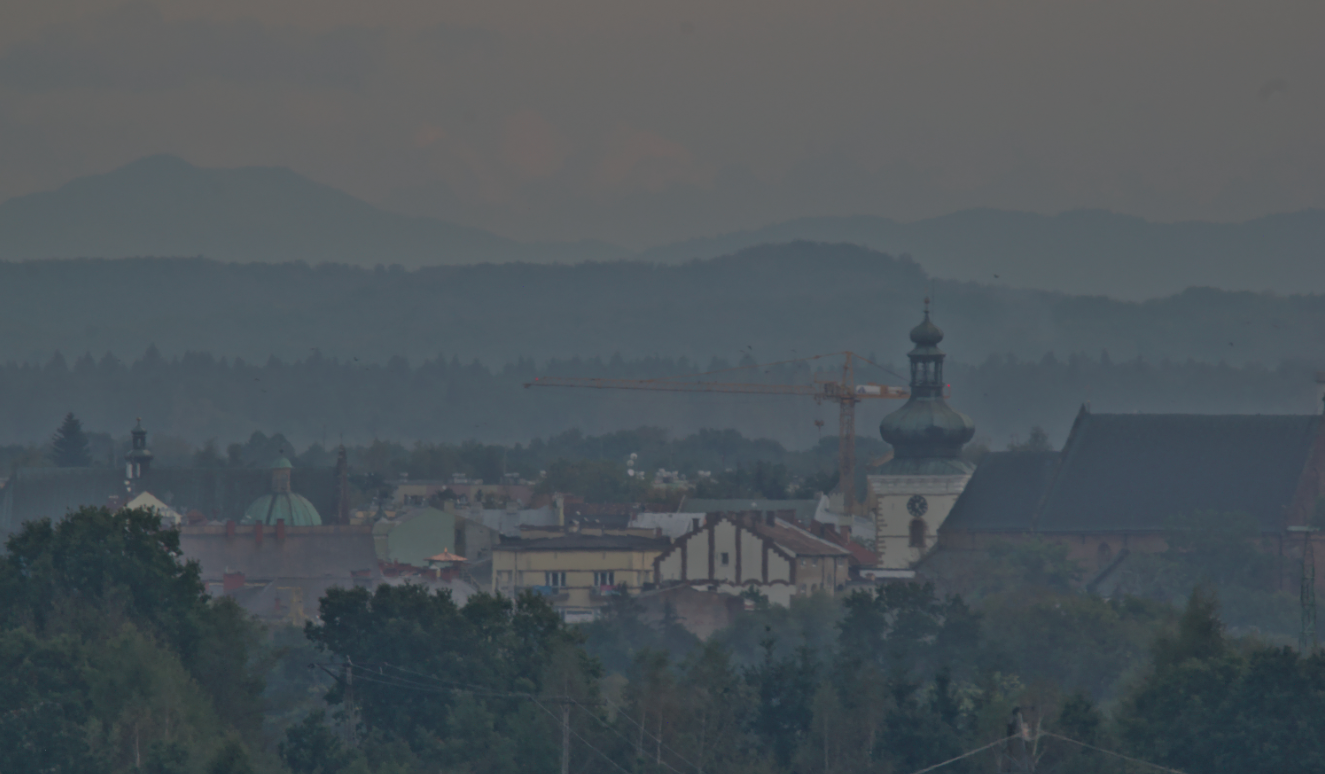Teleconverter 2x (TC-2001) for the 150-600mm f/5-6.3 Contemporary and other Sigma lenses
The Sigma 150-600mm DG OS HSM f/5 – 6.3 + teleconverter kit TC-1401 bundle wasn’t enough for me. I just wanted to see, what the world looks like through the maximum telephoto lens, affordable for many of us at once. The difference in price between the 150-600mm C (or 150-600mm S) + TC-2001 combination and for instance, the Sigma 300-800mm f/5.6 DG EX APO IF HSM is huge. The 300-800mm lens costs an arm and leg really, and you can buy a quite good car for this price. I think, that by having an option for zoom extension up to 1200mm I reached somewhat the top border, considering the reasonable price range and obviously a high-end device. Saying a high-end device I mean something far better than for example the Opteka 420-800mm f/8.3 HD Telephoto Zoom Lens, which costs for a song, although its aperture at 800mm already is out of the question (f/16 vs f/9 in 150-600mm C + TC-1401). Maybe I will have an occasion to test it in the future, who knows? For now, I am going to run you through all the pros and cons of the teleconverter TC-2001 attached to a Sigma 150-600mm f/5 – 6.3 Contemporary lens.
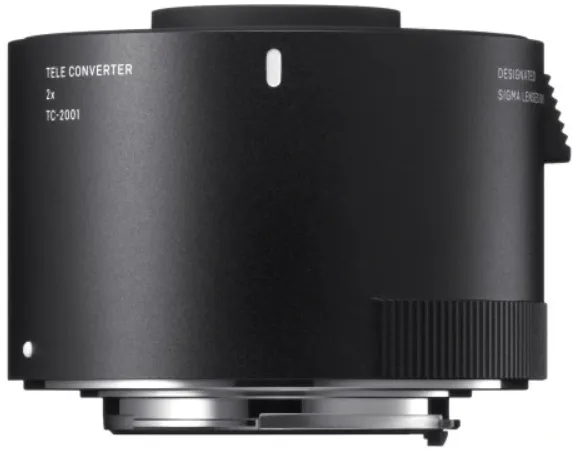
Pic. 1 Sigma teleconverter TC-2001 (Allegro.pl).
- BUILD QUALITY & DESIGN
The teleconverter TC-2001 has exactly the same lens compatibility as its brother, TC-1401, which I described here. The first thing, that comes with it is the combination of them two and gaining 1680mm finally (with aperture f/18). I never tried and I won’t, because the manufacturer doesn’t recommend doing so. The stacking of TC-1401 and TC-2001 might result in the collision of the front and rear elements of these two items. In turn, both of them might be broken and not usable anymore. I think, that they’re too expensive for experiments such as this. Alternatively, you can try the already mentioned focal length Opteka 420-800mm f/8.3 HD Telephoto Zoom Lens with 2x teleconverter in the bundle and enjoy f/29 aperture.
The teleconverter TC-2001 comes with a very solid lens. It’s dust and waterproof. Furthermore, the size of this teleconverter is more convenient to use. It’s about thrice thicker than TC-1401, which simplifies the mount and detachment a lot.
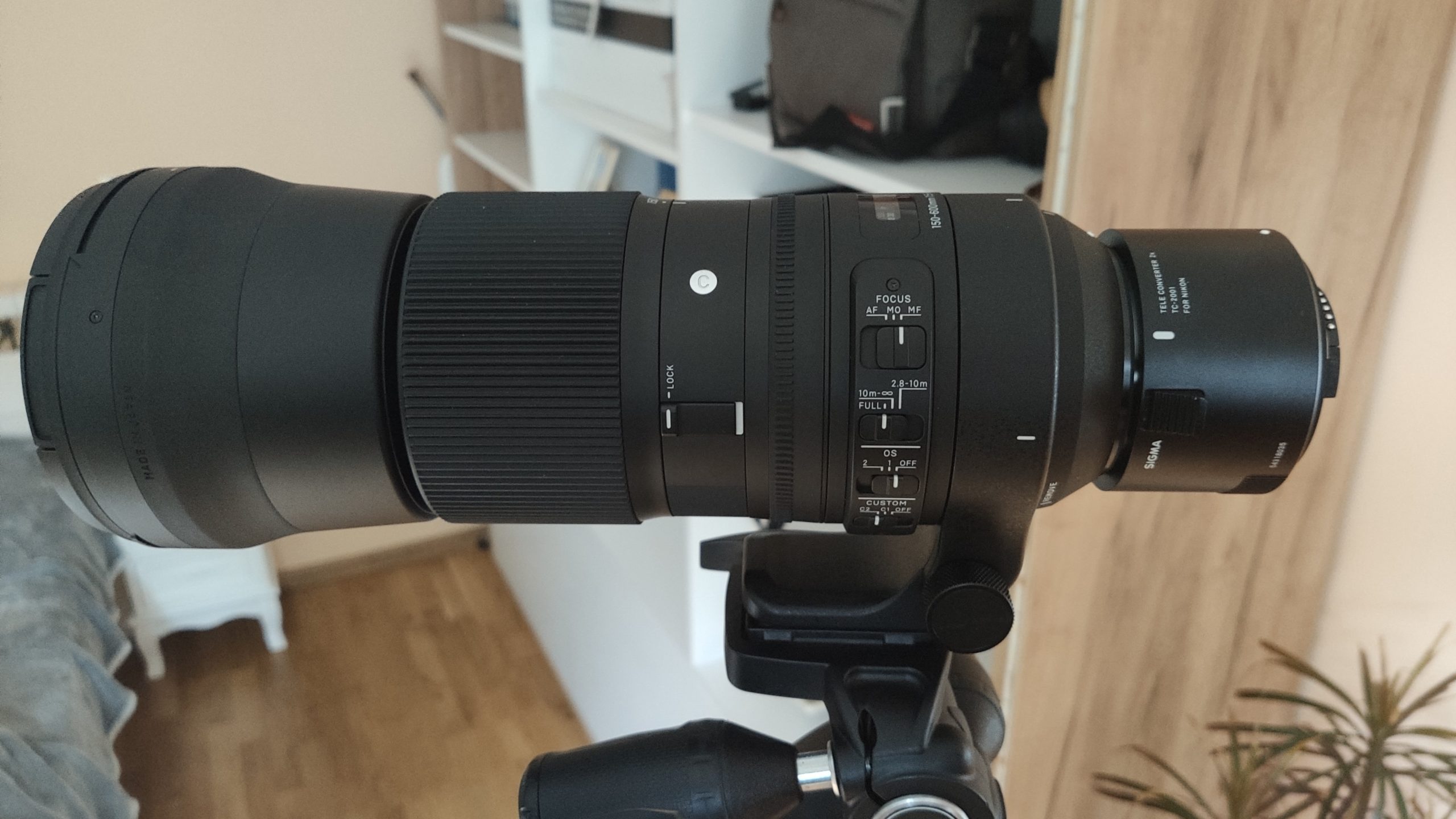
Pic. 2 The TC-2001 teleconverter attached to Sigma 150-600mm DG OS HSM contemporary lens and Nikon D5300 DSRL camera.
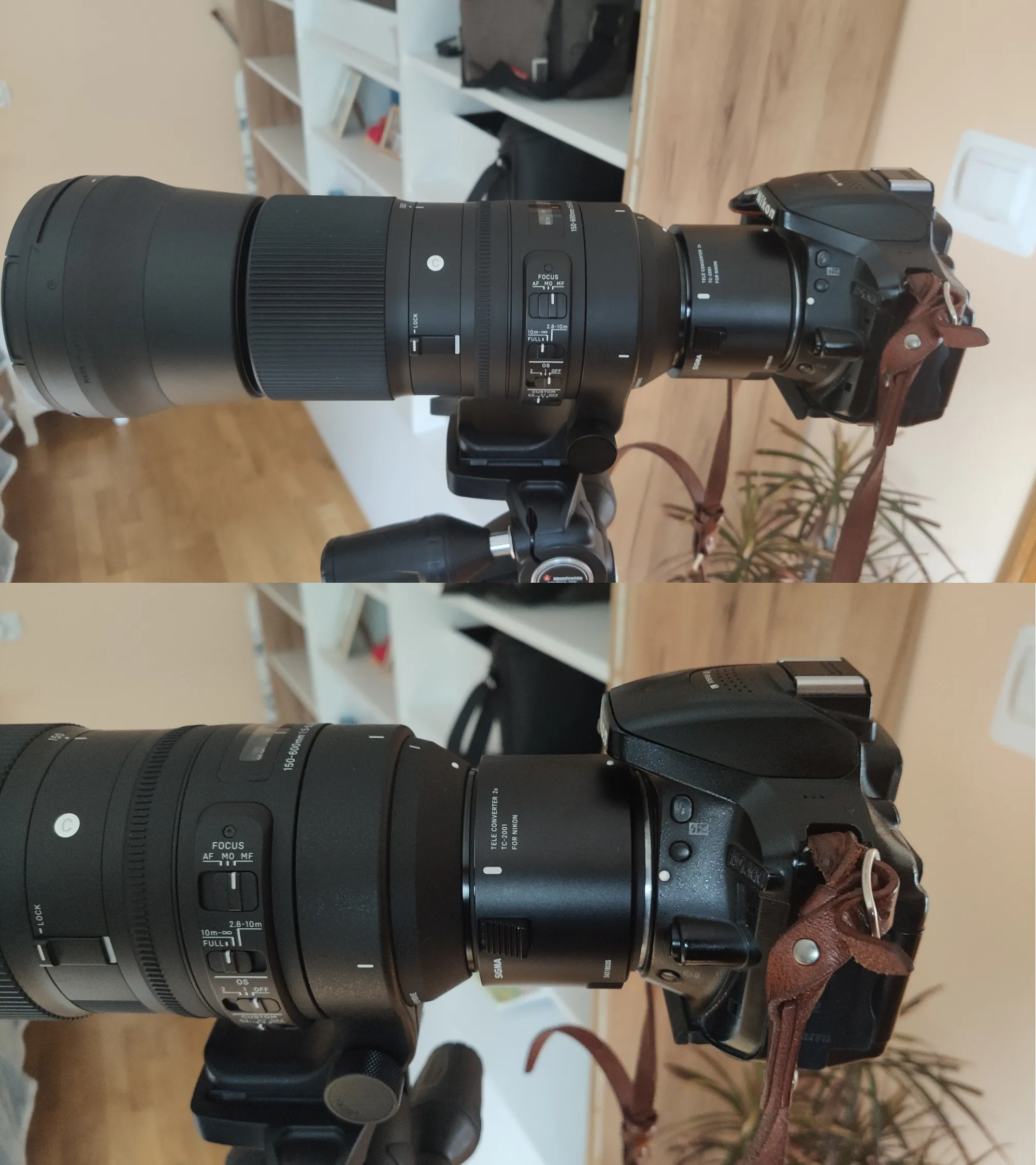
Pic. 3 The TC-2001 teleconverter attached to Sigma 150-600mm DG OS HSM Contemporary lens and Nikon D5300 DSRL camera.
The basic construction of Sigma Teleconverter TC-2001 includes 10 elements in 5 groups.
2. THE MAGNIFICATION
Before I start my amateur test of TC-2001 I would like to say something about the full magnification, which can be gained by 1200mm in total. The basic question, which comes to mind is – what do these “mm” mean? The value of mm is obviously the focal length. Next question then – how can we convert the focal length into the visual optical zoom? On the web, you can find the correct and simple explanation, that the optical zoom value is the ratio between the maximum and minimum focal length. In the case of Sigma 150-600mm f/5 – 6.3 DG OS HSM Contemporary the optical zoom is 4x. It’s fine, but when you look through the 150-600mm, you see that the vista is seriously magnified at the very beginning. So it must be the other factor determining the real optical zoom. The base focal length value, which would correspond to the 1×1 relation includes the human’s eye focal length combined with the size of the frame sensor. I am going to develop this topic in the future. Now, I prepared some example images from various distances in order to gauge the real 1200mm magnification compared to my eyes (Pic. 4-9).
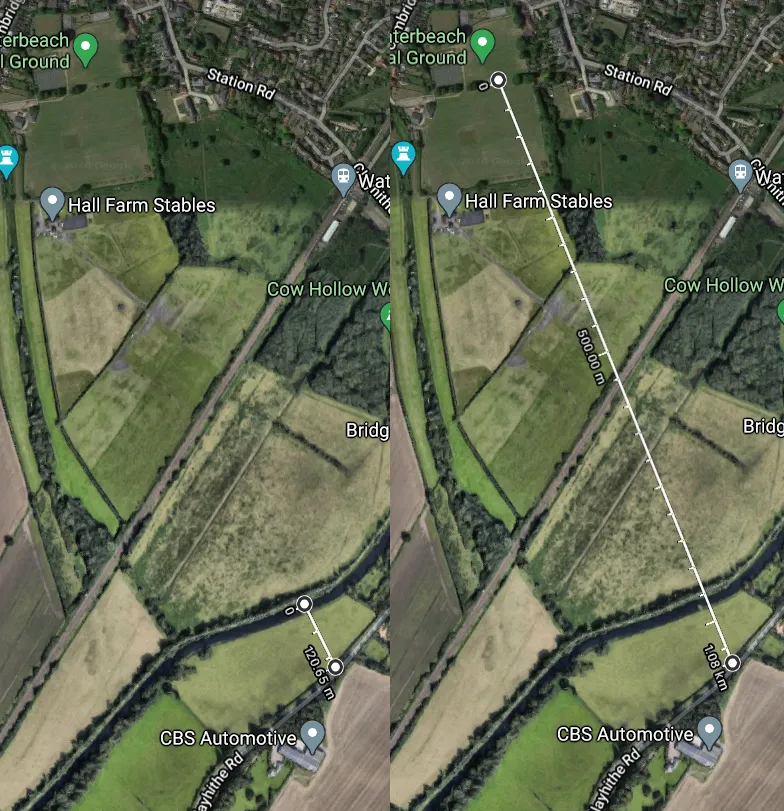

Pic. 4 – 6 The 1200mm comparison to the normal view. About 9x difference in the distance still makes objects bigger when watching them through a 1200mm lens. The upper image is a normal photo with a 1x optical zoom taken by Xiaomi Mi 9. The lower image shows the same objects captured by Sigma 150-600mm C + TC-2001 at 1200mm. They look about 5x bigger despite a 9x bigger distance. For better comparison I’ve made the crops, adjusting them to 12Mpx (1/2″ CMOS sensor) images available in the standard Xiaomi Mi 9 photography mode. Waterbeach, UK. Click to enlarge.
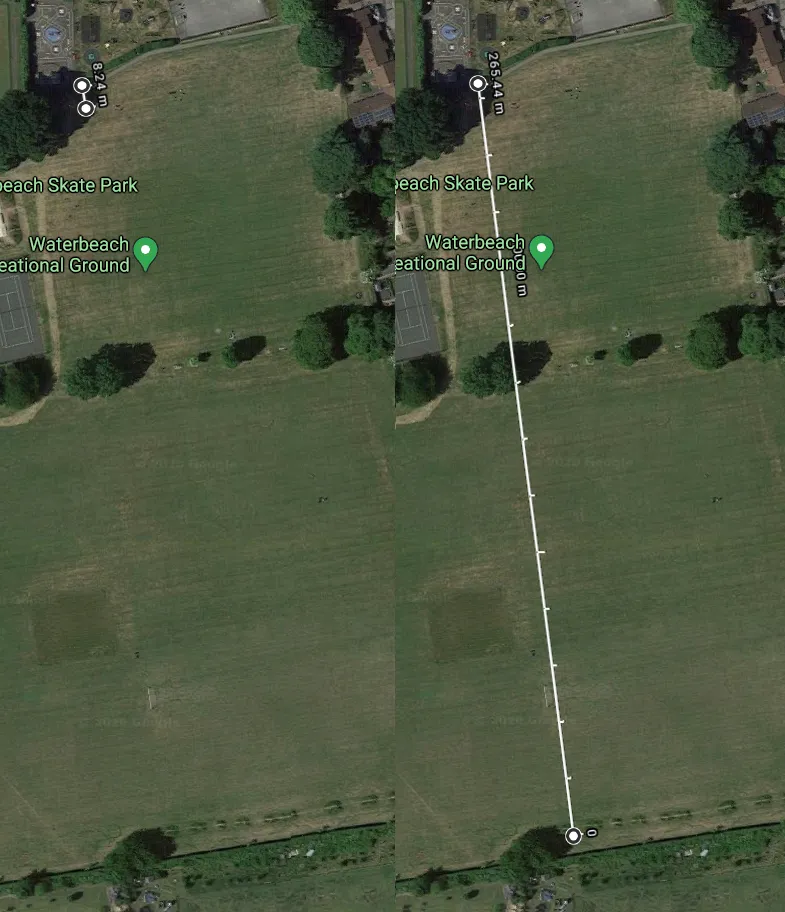

Pic. 7,8 The text view comparison in Waterbeach Recreation Ground between the normal view (top) and 1200mm (bottom). The normal view was captured by Sigma 18-35mm f/1.8 Art at a 24mm focal length. It was the distance, where the text was at the border of readability by my eyes. The same effect pretty much I could get with 1200mm from about 32x longer distance. However, all the flaws caused by TC-2001 have been excluded here On top of that, the text boxes look still bigger than above. Waterbeach Recreation Ground, UK. Click to enlarge.
My simple investigation combined with basic web knowledge so far leads to the conclusion, that the 1200mm corresponds to 50x optical zoom in total. This is obviously the range of small telescopes.
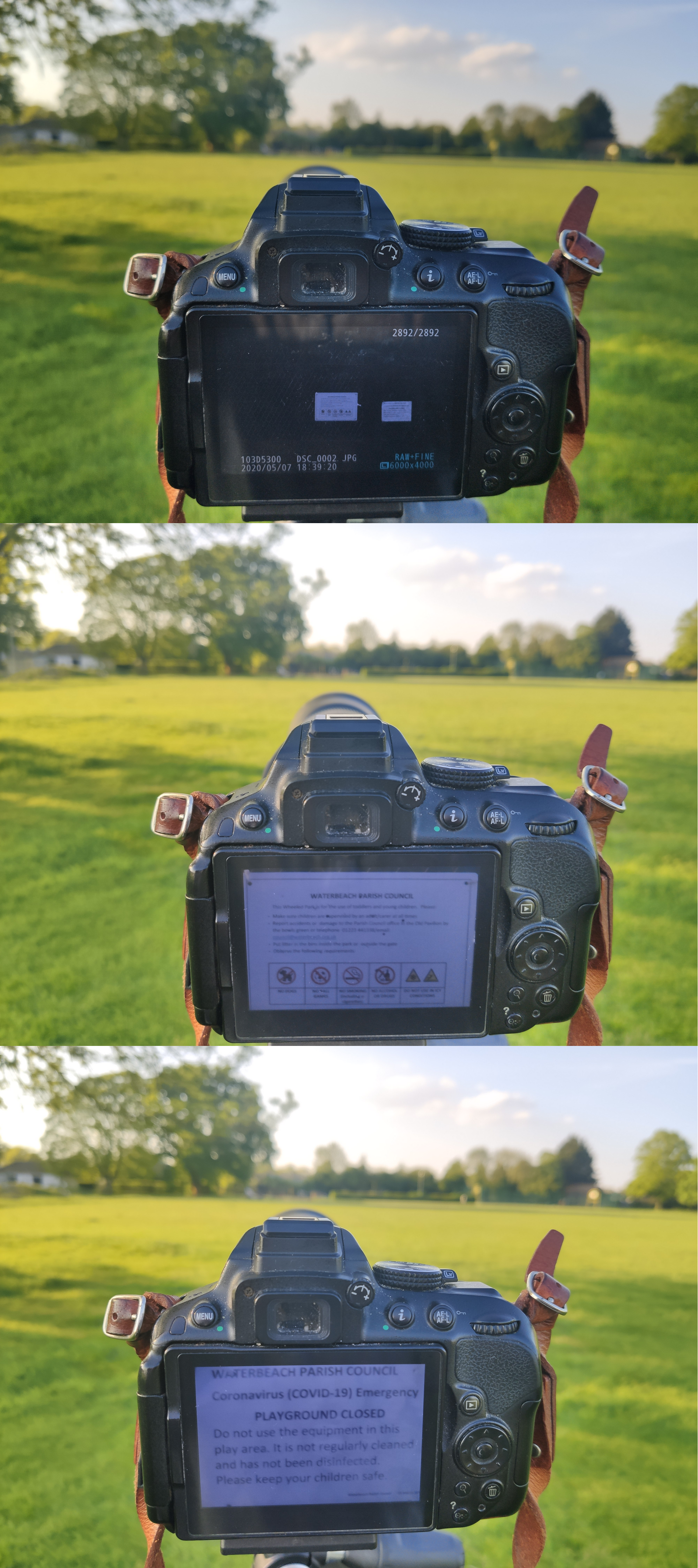
Pic 9 The power of teleconverter 2x TC-2001 mounted to Sigma 150-600mm f/5 – 6.3 Contemporary lens. Waterbeach Recreation Ground, UK.
3. SHARPNESS AND IMAGE RESOLUTION
This is obviously the most important thing, which shapes our final decision to purchase this item or not. However, the sharpness usually depends on the lens the teleconverter is coupled with. The image quality taken on the longest focal length of 1000 – 1200mm will be also the camera and tripod dependant. This range of magnification is very sensitive to any, even smallish vibrations. In this case, the mirror lockup would be essential. Otherwise, even if you use the tripod, a faster shutter speed is required. In my case at least 1/320s. Otherwise, the vibrations can double our image with at least a 1-pixel move, which won’t look as sharp as you want it. Moreover, the long-distance purpose is somewhat doomed to fail in advance. The major culprit of it is the heat shimmer (heat haze), making our landscape blurry as it’s located further from the observer and a lot of heat is released from the ground at the observer-object line. The last factor determining the overall sharpness by TC-2001 is obviously the sharpness of the lens. We know already, that Sigma 150-600mm f/5 – 6.3 DG OS HSM Contemporary tends to degrade the sharpness at its maximum focal length, between 500 and 600mm. It will definitely impact the final sharpness gained with the TC-2001 mount, because the 2x teleconverter will double the signs of defects from the lens, and next add another defect from the extender.
The sharpness of the TC-2001 maximum focal length appears to be really good when attached to the Sigma 150-600mm f/5 – 6.3 Sports lens (Pic. 10).
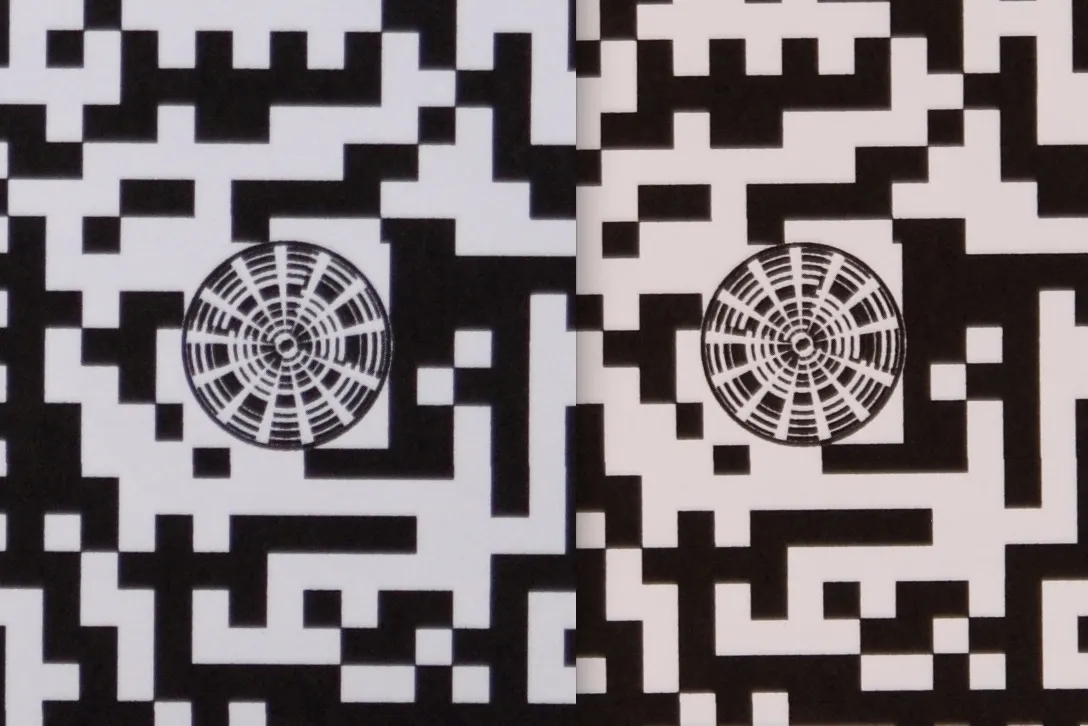
Pic. 10 The sharpness at 600mm received from the Sigma 150-600mm f/5 – 6.3 Sport at 600mm (right) and with TC-2001 mount at 600mm (300×2) on the left, 100% crop (Dpreview.com).

Pic 11 The 1200mm focal length image quality gained from TC-2001 mounted to Sigma 150-600mm f/5 – 6.3 Sport at 100% crop (Dpreview.com).
The image doesn’t look as clear as above when TC-2001 is attached to the Sigma 150-600mm f/5 – 6.3 Contemporary version. The laboratorian tests below show worse quality, which eventually tends to improve as the aperture gets narrower. Unfortunately, the difference in quality at 1200mm is streaking between the Contemporary and Sport versions (Pic. 12).

Pic. 12 The 1200mm focal length test at TC-2001 attached to Sigma 150-600mm f/5 – 6.3 Contemporary lens (The-Digital-Picture.com). Click to enlarge.
In this case, I can’t say about the credibility of this test against my field one, because it covers the f/13 and f/16 apertures only. In this range, the sharpness tends to improve. My field tests show the typical image resolution changes, typical for both Sigma 150-600mm f/5 – 6.3 Contemporary lens and teleconverter 1.4x TC-1401 kit attached. Another issue, that comes to mind, and should be definitely raised here is the relation between the aperture and diffraction, which gets bigger as the aperture becomes more narrow. Diffraction occurs when the wave encounters some obstacle or opening. The result is the bending of waves around the corners of the obstacle into the region of the geometrical shadow of this obstacle (Pic. 13).
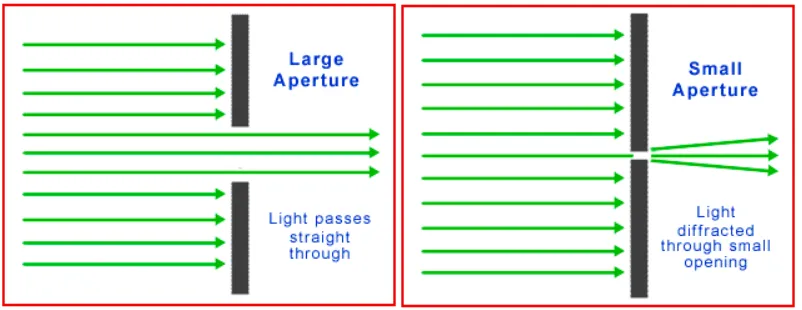
Pic. 13 The simple sketch showing the relation between aperture and diffraction (Earthboundlight.com).
In photography, diffraction means the progressive loss of sharpness beyond some certain aperture. Each lens has its own minimum usable aperture, which must be figured out. In the case of TC-2001 mounted to Sigma 150-600mm f/5 – 6.3 Contemporary lens, the minimum usable aperture is about F18-F20, as you can see below (Pic. 14-21).

Pic. 14 The Teleconverter 2x TC-2001 mounted to Sigma 150-600mm f/5 – 6.3 Contemporary and image sharpness at 300mm and ISO 160. View at Krosno from Ustrobna in Poland. Click to enlarge.

Pic. 15 The Teleconverter 2x TC-2001 mounted to Sigma 150-600mm f/5 – 6.3 Contemporary image sharpness at 300mm, ISO 160 and f/16 and f/18 cropped. View at Krosno from Ustrobna in Poland. Click to enlarge.
At 300mm focal length (150×2) the minimum usable, or at least the best aperture seems to be f/16. A small sharpness deterioration is to be spotted at f/18.

Pic. 16 The Teleconverter 2x TC-2001 mounted to Sigma 150-600mm f/5 – 6.3 Contemporary image sharpness at 600mm, ISO 1000, and various apertures. View at Krosno from Ustrobna in Poland. Click to enlarge.

Pic. 17 The Teleconverter 2x TC-2001 mounted to Sigma 150-600mm f/5 – 6.3 Contemporary image sharpness at 600mm, ISO 1000, and f/16 and f/18 cropped. View at Krosno from Ustrobna in Poland. Click to enlarge.
At 600mm (300×2), this deterioration is almost gone. It means, that the f18 is as good as f/16 for imaging with TC-2001 attached.
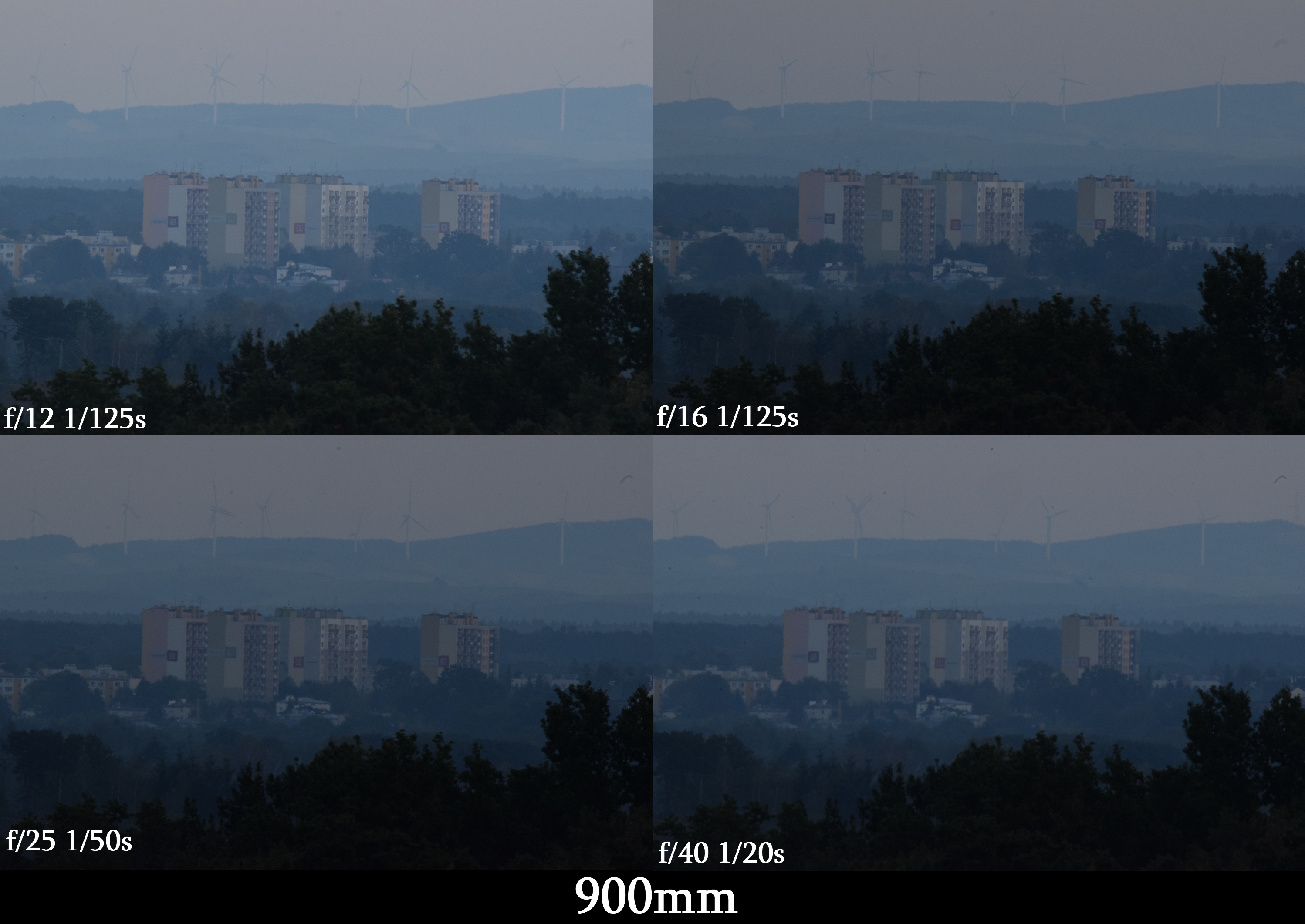
Pic. 18 The Teleconverter 2x TC-2001 mounted to Sigma 150-600mm f/5 – 6.3 Contemporary image sharpness at 900mm, ISO 1000, and various apertures. View at Krosno from Ustrobna in Poland. Click to enlarge.
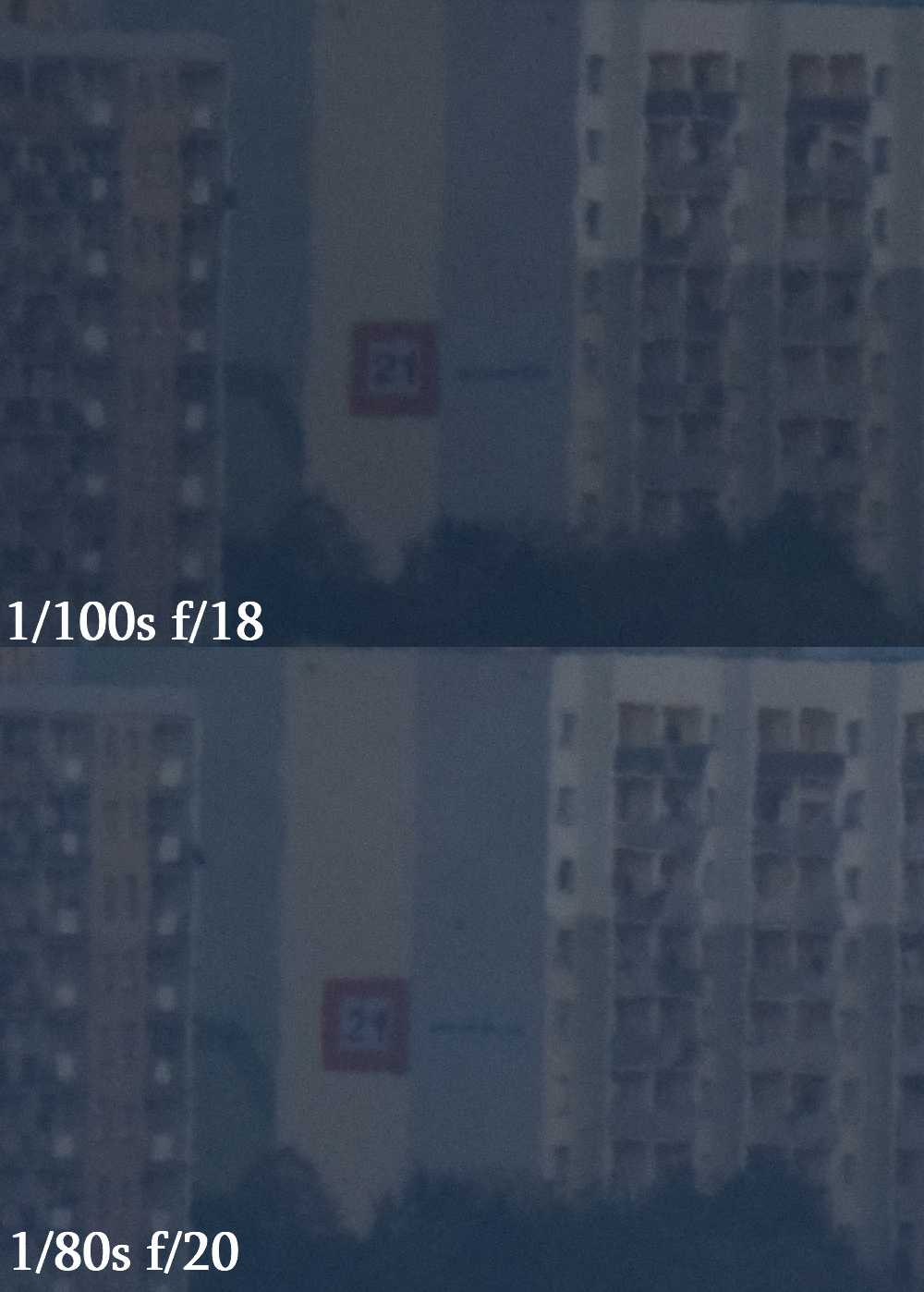
Pic. 19 The Teleconverter 2x TC-2001 mounted to Sigma 150-600mm f/5 – 6.3 Contemporary image sharpness at 900mm, ISO 1000, and f/18 and f/20 cropped. View at Krosno from Ustrobna in Poland. Click to enlarge.
The opposite situation is observed at 900mm (450×2), where the sharpness tends to be better at f/20, but it gets worse at lower apertures.

Pic. 20 The Teleconverter 2x TC-2001 mounted to Sigma 150-600mm f/5 – 6.3 Contemporary image sharpness at 900mm, ISO 1000, and various apertures. View at Krosno from Ustrobna in Poland. Click to enlarge.

Pic. 21 The Teleconverter 2x TC-2001 mounted to Sigma 150-600mm f/5 – 6.3 Contemporary image sharpness at 1200mm, ISO 1000 and f/18 and f/120 cropped. View at Krosno from Ustrobna in Poland. Click to enlarge.
It looks like, at 1200mm focal length, the f/16 is the best aperture for use. The f/18 seems to be the narrowest capable aperture to use.
The overall landscape sharpness can be often hidden, at least partially when applying some sharpening tools. Notwithstanding the level of blur, there is no tool available (at least within the Opensource market), which could make our image as fully sharp as we want. Even the smallest sharpening deterioration in our image is to be visible in our picture, not necessarily cropped. The TC-2001, unfortunately, does have a loss of sharpness, which can be seen yet at a smaller focal length, comparable with the situation, when the item is taken off (Pic. 22).

Pic. 22 The landscape image comparison between the Sigma 150-600mm f/5 – 6.3 Contemporary lens used solely and with the teleconverter 2x TC-2001 attached. View towards Slovakian High Tatra mountains from the Dynowskie Foothills in Poland at about 135km distance. Both images have been slightly enhanced with sharpening ode due to the heat shimmer observed. Kiczary 438m.a.s.l., Rzepnik, Poland. Click to enlarge.
When taking distant landscape photography, you can always find some way to get over the problem of not having enough sharpness. The situation is much worse when we want to capture some far-off text. Unlike the teleconverter 1.4x TC-1401, where the text was visible throughout a whole focal range between 300 and 600mm, in the TC-2001 mounted only the 600mm gives us the opportunity to read the text from about 70 meters. Obviously, these circumstances are specific, as we have the grey text giving relatively small contrast with its background (Pic. 24).

Pic. 23-24 The image sharpness based on text readability comparison from about 70m distance at the same focal length with and without TC-1401 and TC-2001 attached to Sigma 150-600mm Contemporary version, where 23 – full, 24 cropped image. Świerzowa Polska, Poland. Click to enlarge.
As the conformation of the significant sharp loss between Sigma 150-600mm f/5 – 6.3 Contemporary lens and teleconverter TC-2001 attached I took the text photo from about 100m distance. Font size is between 36 to 72 too (Pic. 25).
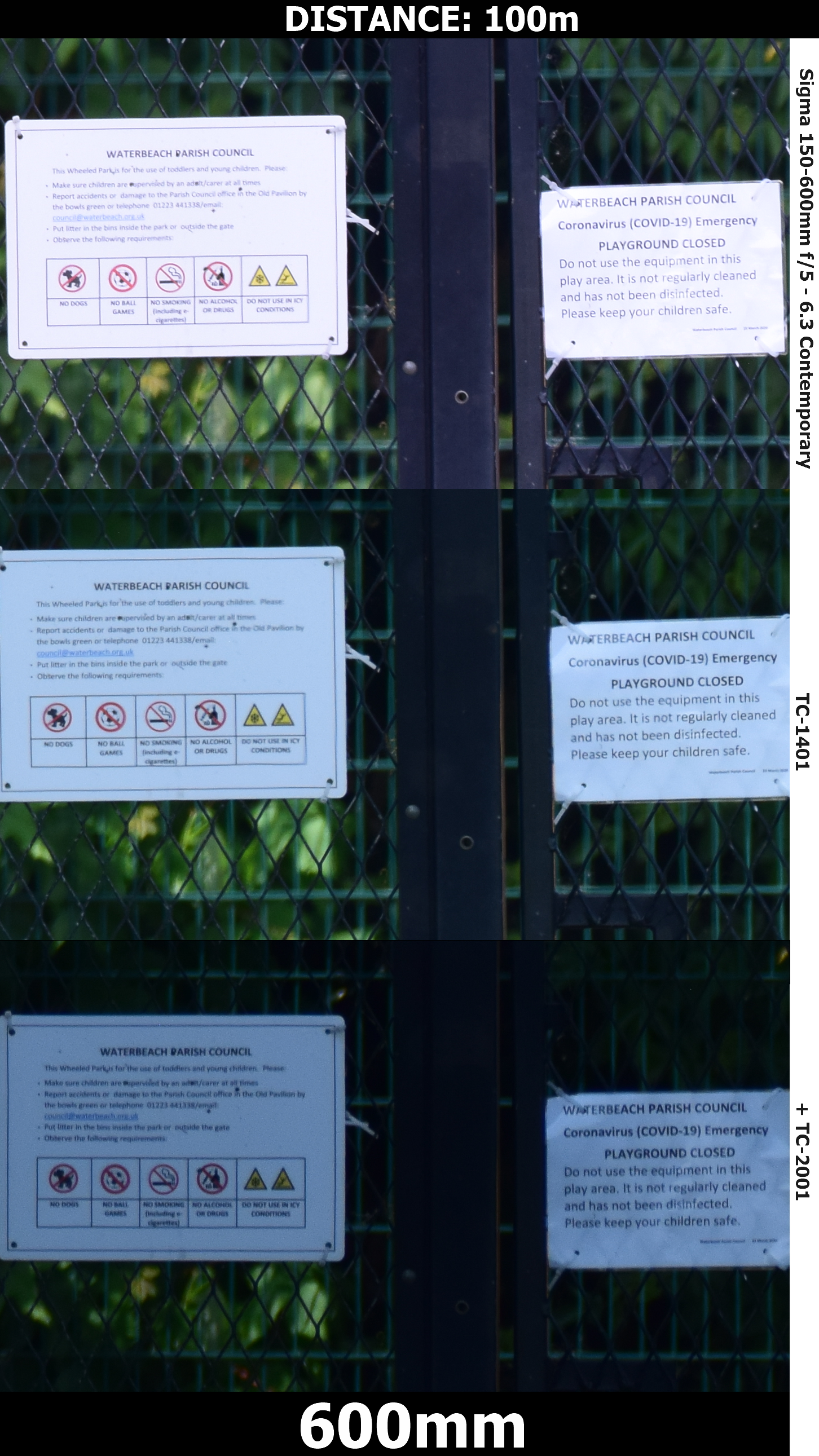
Pic. 25 The distant text visibility comparison is a good way to visual sharpness assessment. The text with a font size between 36 and 72 has been captured from about 100m distance in Waterbeach Recreation Ground in the UK. Unfortunately, the sharpness loss in TC-2001 appears to be significant. Click to enlarge.
Other examples of distant text reading have been obtained from 90m (Pic. 26) and 260m (Pic. 27-28) distance.

Pic. 26 The text reading ability at 1200mm focal length from 90m distance. with some cropped sections visible. Waterbeach Recreation Groud, UK. Click to enlarge.
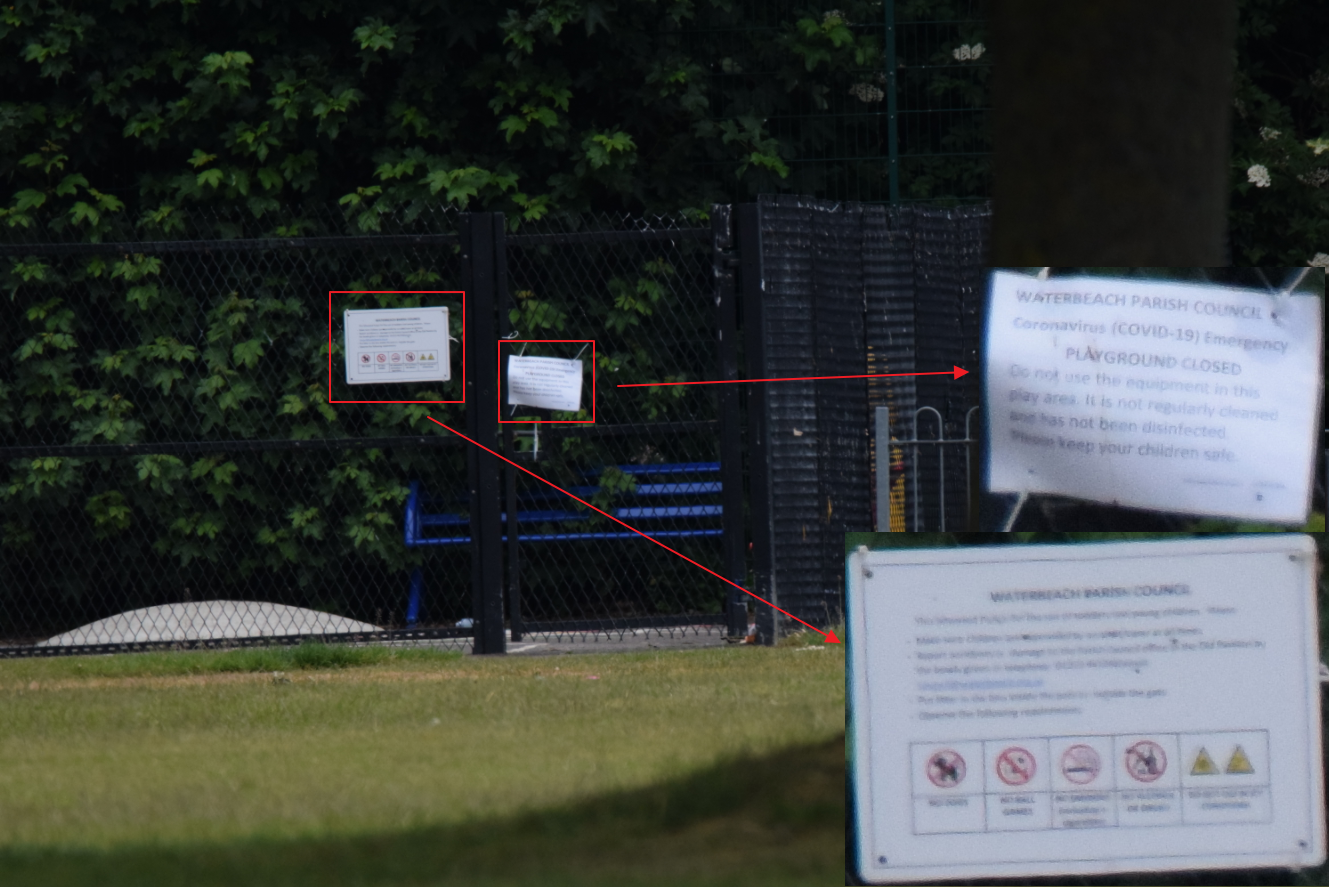
Pic. 27, 28 The text readability from about 260m distance in Waterbeach Recreation Ground. The text is hardly visible at 1200mm, which proves the sharpness quality issues of TC-2001. Click to enlarge.
The quality is definitely worse than with TC-1401 unfortunately. Even at a smaller magnification of 840mm, the text is better visible than at 1200mm (Pic. 29).

Pic. 29 The text readability comparison between TC-1401 and TC-2001 attached to Sigma 150-600mm f/5 – 6.3 DG OS HSM Contemporary lens. Waterbeach Recreation Ground. Click to enlarge.
My amateur test reveals not the best sharpness of the Sigma teleconverter 2x TC-2001, which appears to be significantly worse than gained from TC-1401. I guess also the price might play a role here, whereas the TC-1401 costs just £50 less than the TC-2001 when buying it separately. The images captured, especially at 1200mm focal length can be at most acceptable. There is no way about a perfect sharpening. I guess the reason is the cheaper version of the Sigma 150-600mm lens, which I have, which is clearly shown above (Pic. 10 – 12). Another factor might be the tripod or DSLR camera, which was also mentioned above.
4. DISTORTION
The distortion issue is almost gone when using the Sigma teleconverter 2x TC-2001 attached to the Contemporary version of the 150-600mm lens. It’s obviously very good news for someone, who wants to make panoramic images. I can admit with a heartbeat, that from this angle of view, the TC-2001 works very well (Pic. 30- 35).

Pic. 30 The Tatra Mts seen from the Dynowskie Foothills (Rzepnik) in Poland at about 135km distance and 300mm focal length through the Sigma teleconverter 2x TC-2001 attached to Sigma 150-600mm Contemporary. The image has been sharpened in order to reduce fuzziness caused by heat haze. Kiczary 438m.a.s.l., Rzepnik, Poland. Click to enlarge.

Pic. 31 The Tatra Mts seen from the Dynowskie Foothills (Rzepnik) in Poland at about 135km distance and 600mm focal length through the Sigma teleconverter 2x TC-2001 attached to Sigma 150-600mm Contemporary. The image has been sharpened in order to reduce fuzziness caused by heat haze. Kiczary 438m.a.s.l., Rzepnik, Poland. Click to enlarge.

Pic. 32 The Tatra Mts as seen from the Dynowskie Foothills (Rzepnik) in Poland at about 135km distance and 800mm focal length through the Sigma teleconverter 2x TC-2001 attached to Sigma 150-600mm Contemporary. The image has been sharpened in order to reduce fuzziness caused by heat haze. Kiczary 438m.a.s.l., Rzepnik, Poland. Click to enlarge.

Pic. 33 The Tatra Mts as seen from the Dynowskie Foothills (Rzepnik) in Poland at about 135km distance and 900mm focal length through the Sigma teleconverter 2x TC-2001 attached to Sigma 150-600mm Contemporary. The image has been sharpened in order to reduce fuzziness caused by heat haze. Kiczary 438m.a.s.l., Rzepnik, Poland. Click to enlarge.

Pic. 34 The Tatra Mts as seen from the Dynowskie Foothills (Rzepnik) in Poland at about 135km distance and 1000mm focal length through the Sigma teleconverter 2x TC-2001 attached to Sigma 150-600mm Contemporary. The image has been sharpened in order to reduce fuzziness caused by heat haze. Kiczary 438m.a.s.l., Rzepnik, Poland. Click to enlarge.

Pic. 35 The Tatra Mts seen from the Dynowskie Foothills (Rzepnik) in Poland at about 135km distance and 1200mm focal length through the Sigma teleconverter 2x TC-2001 attached to Sigma 150-600mm Contemporary. The image has been sharpened in order to reduce fuzziness caused by heat haze. Kiczary 438m.a.s.l., Rzepnik, Poland. Click to enlarge.
5. VIGNETTING
The vignetting seems to be slightly higher than the 1.4x magnifier TC-1401, although still remains much smaller than at Sigma 150-600mm f/5 – 6.3 Contemporary without any additional mount.
The value of vignetting exceeds -0,1EV at the top right corner, but predominantly reaches -0,05EV at the 1200mm focal length (Pic. 36).

Pic. 36 The vignetting issues in Sigma 150-600mm f/5 – 6.3 DG OS HSM Contemporary lens and both teleconverters.
The same as at TC-1401 as well as Sigma 150-600mm Contemporary lens only, the biggest vignetting appears at the widest aperture. Likewise, at TC-1401 this disadvantage disappears quickly as the aperture is narrowed down. Yet at one stop light down from the maximum, there is no vignetting observed (Pic. 37).
Beyond f/16 the vignetting is not visible anymore. This is a very good attitude for the TC-2001 teleconverter.
6. CHROMATIC ABERRATION
Chromatic aberration comes out quite seriously in the images taken by TC-2001 attached. It’s not much visible up to 600mm on fitted images. In cropped pictures the flaw is significant, giving a bluish appearance on the right and whitish-grayish on the left. (Pic. 38 – 39).
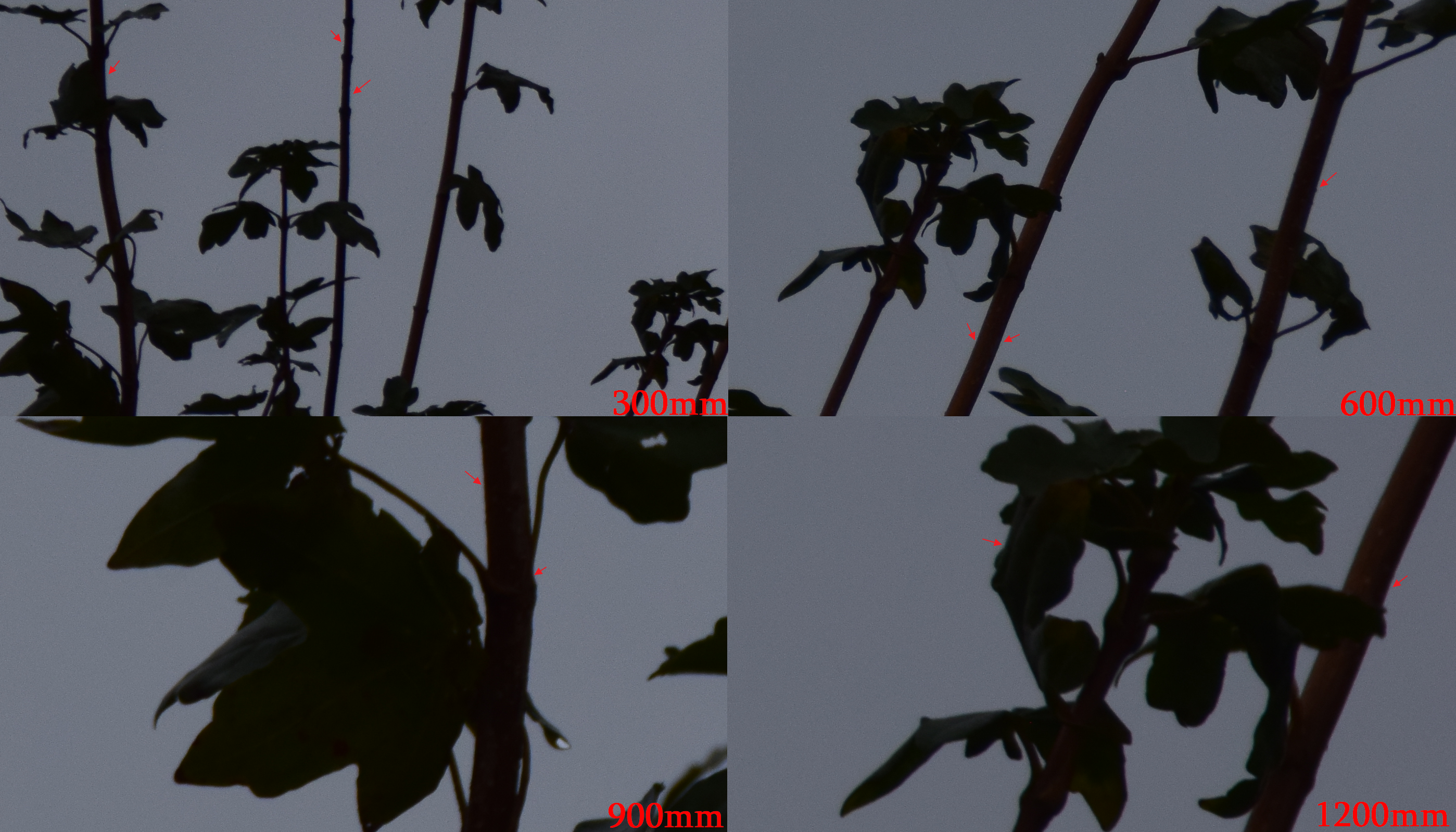
Pic. 38 – 39 The chromatic aberration issues in the images taken by teleconverter TC-2001 attached to Sigma 150-600mm f/5 – 6.3 Contemporary lens. Exif: 1/400s, ISO 400, f/11-13. Click to enlarge.
The flaw is significantly disturbing when taking images at the maximum focal length (Pic. 40), which is quite disturbing, especially when capturing some celestial objects (Pic. 41-42).
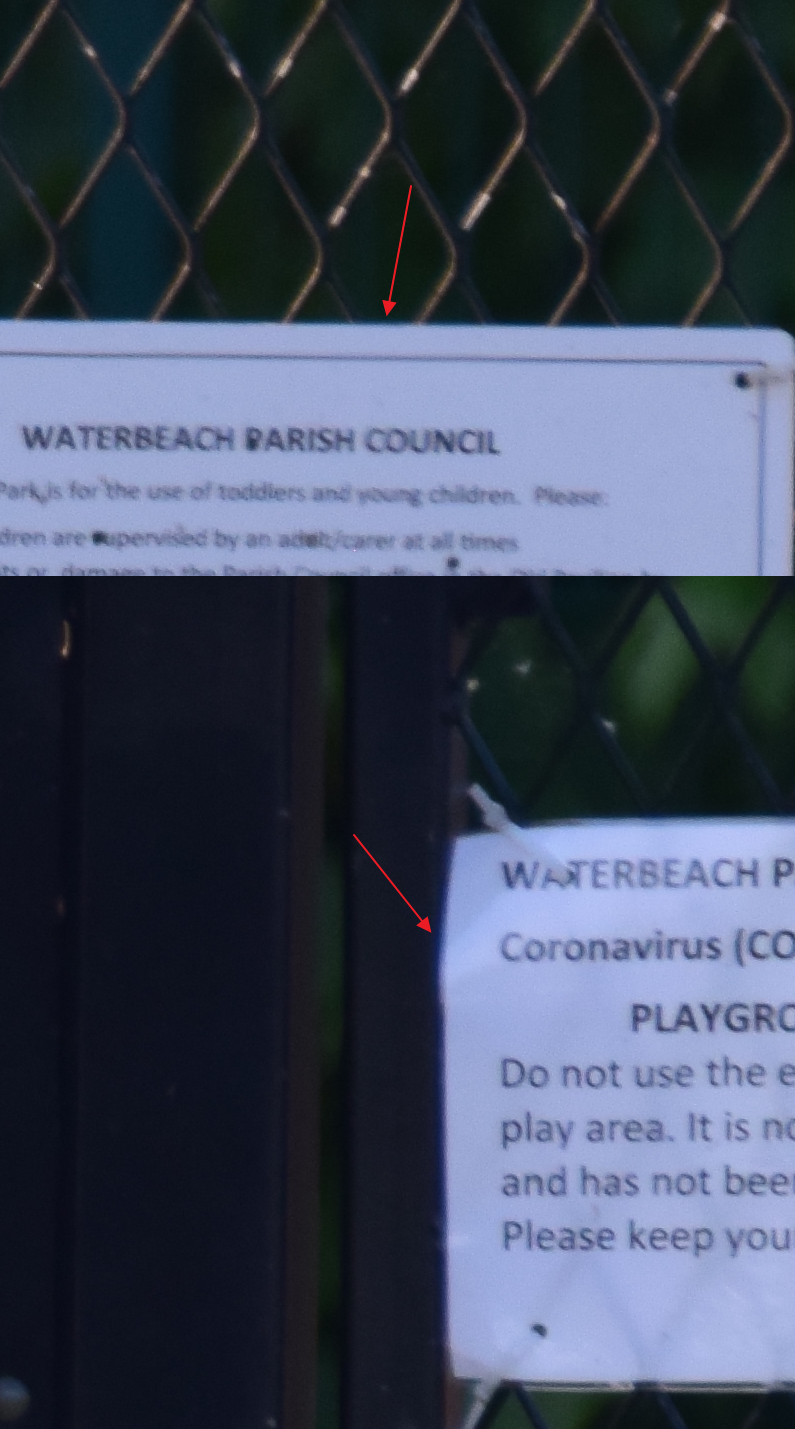
Pic. 40 The bluish appearance at the borders of different contrast. Exif: 1200mm, 1/125s, f/13, ISO 640.

Pic. 41 The serious chromatic aberration flaw visible at the brightest celestial objects, giving them the additional bluish to reddish hint. Exif: 1200mm, 1/125s, f/13, ISO 800, cropped.
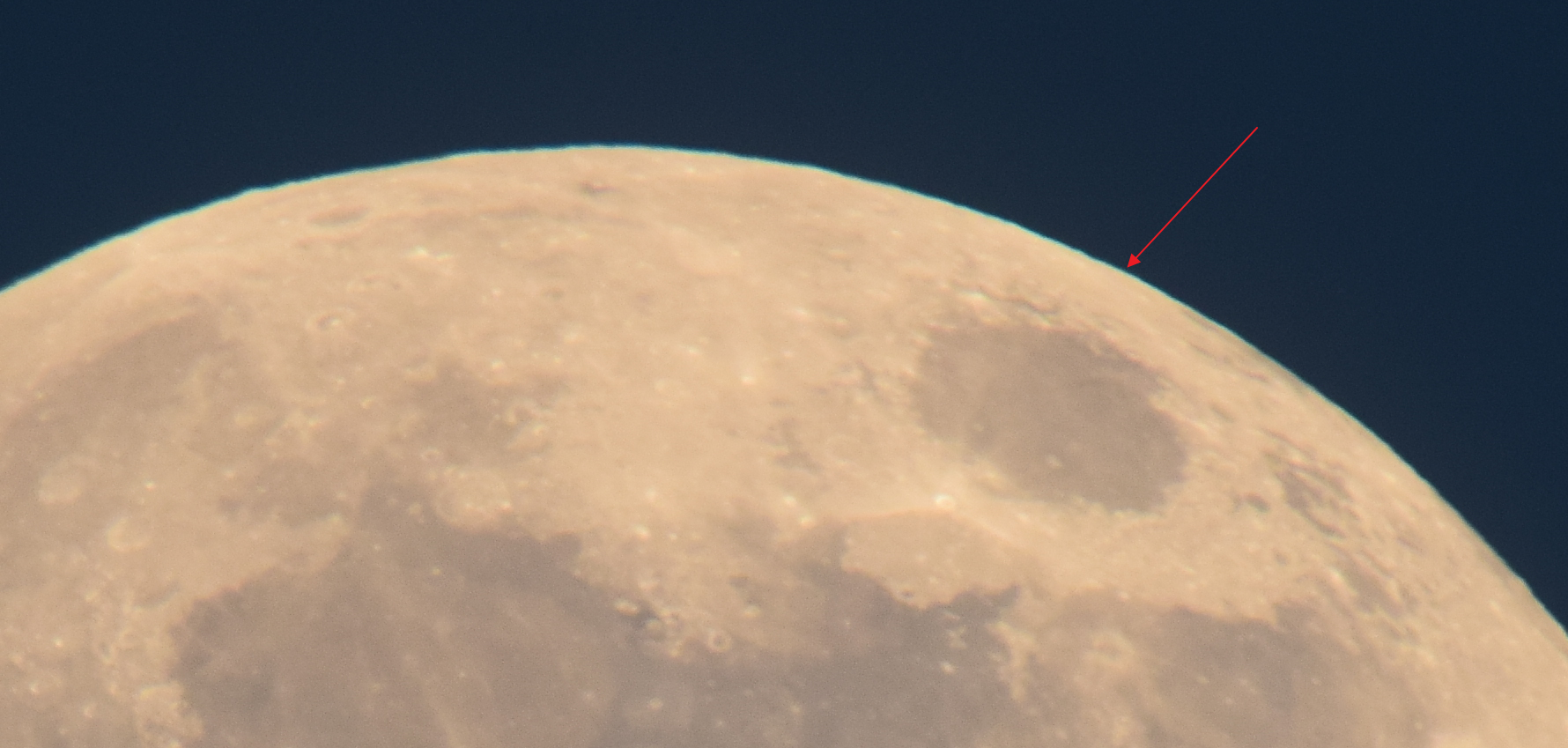
Pic. 42 Serious chromatic aberration seen at the lunar limb. Exif: 1200mm, 1/160s, f/ ISO 400, 50% cropped.
Unfortunately, the focal length of 1000mm and longer excludes some ways of photography. If your objects have a big contrast with their surroundings, possibly you should consider another item. Objects featuring a smaller contrast with the background should be fine.
7. COMA & ASTIGMATISM
The coma aberration is almost invisible at a whole focal length range. It’s good information. The Sigma 150-600mm f/5 – 6.3 Contemporary lens doesn’t feature this disadvantage really, what was shown. The TC-2001 doesn’t either.


Pic. 43,44 The coma aberration in the images taken by TC-2001 mounted to Sigma 150-600mm Contemporary, the Capella star, second brightest in the northern sky. Exif: 1s, f/13, ISO 1250.
There is almost no coma aberration here. The shape-looking star is a result of poor sharpness and astigmatism. The various coloration comes from the chromatic aberration described above.
The astigmatism flaw is quite big, unfortunately. It brings an additional fuzziness to our images, especially at the longest focal length.
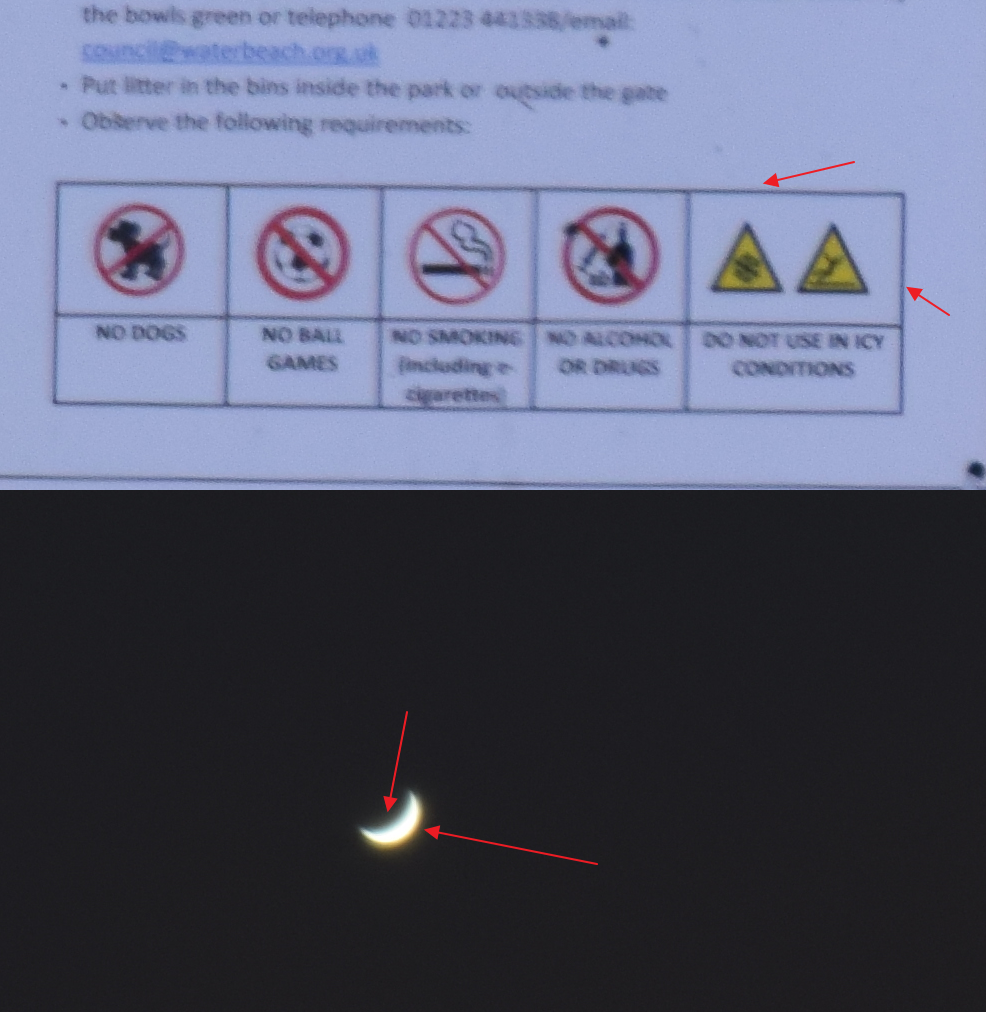
Pic. 45 Astigmatism visible in the images captured at 1200mm by TC-2001 attached to Sigma 150-600mm Contemporary lens. Exif: (upper) 1200mm, 1/125s, f/13, ISO 640; (lower) 1200mm, 1/10s, f/29, ISO 100.
Astigmatism gets bigger at a focal length of 900mm and beyond. This is obviously a sad thing because it additionally deteriorates image quality. Some astigmatism comes from the Sigma 150-600mm Contemporary lens, which is doubled with the teleconverter TC-2001.
8. BOKEH & NEAREST DISTANCE
The bokeh produced by TC-2001 attached to Sigma 150-600mm is good. I had no issues with it. The light spreads evenly in all directions both in TC-1401 and TC-2001 attached to the main lens (Pic. 46).

Pic. 46 Bokeh in the image taken by teleconverter TC-2001 attached to Sigma 150-600mm f/5 – 6.3 Contemporary lens.
The sharp images can be shot from about 280cm, which is perfect! You might already know, that Sigma 150-600 has sharpness regulation from infinity down to 2.8m. According to my measurements, you can take sharp shots even from 2.5m. Having the TC-2001 mounted to this lens, we can get sharp images from 2.8m. It’s great! The macro-looking images look very well, unlike the distant objects photographed. The major factor here is the air, which often remains unstable at long lines of sight, where a lot of heat shimmers and turbulences occur. Here, we’ve got only 3 meters effectively, so the air movement is not visible at all. In torn, the sharpness of our object is perfect and restricted to the manufacturer’s flaws only (Pic. 47, 48).
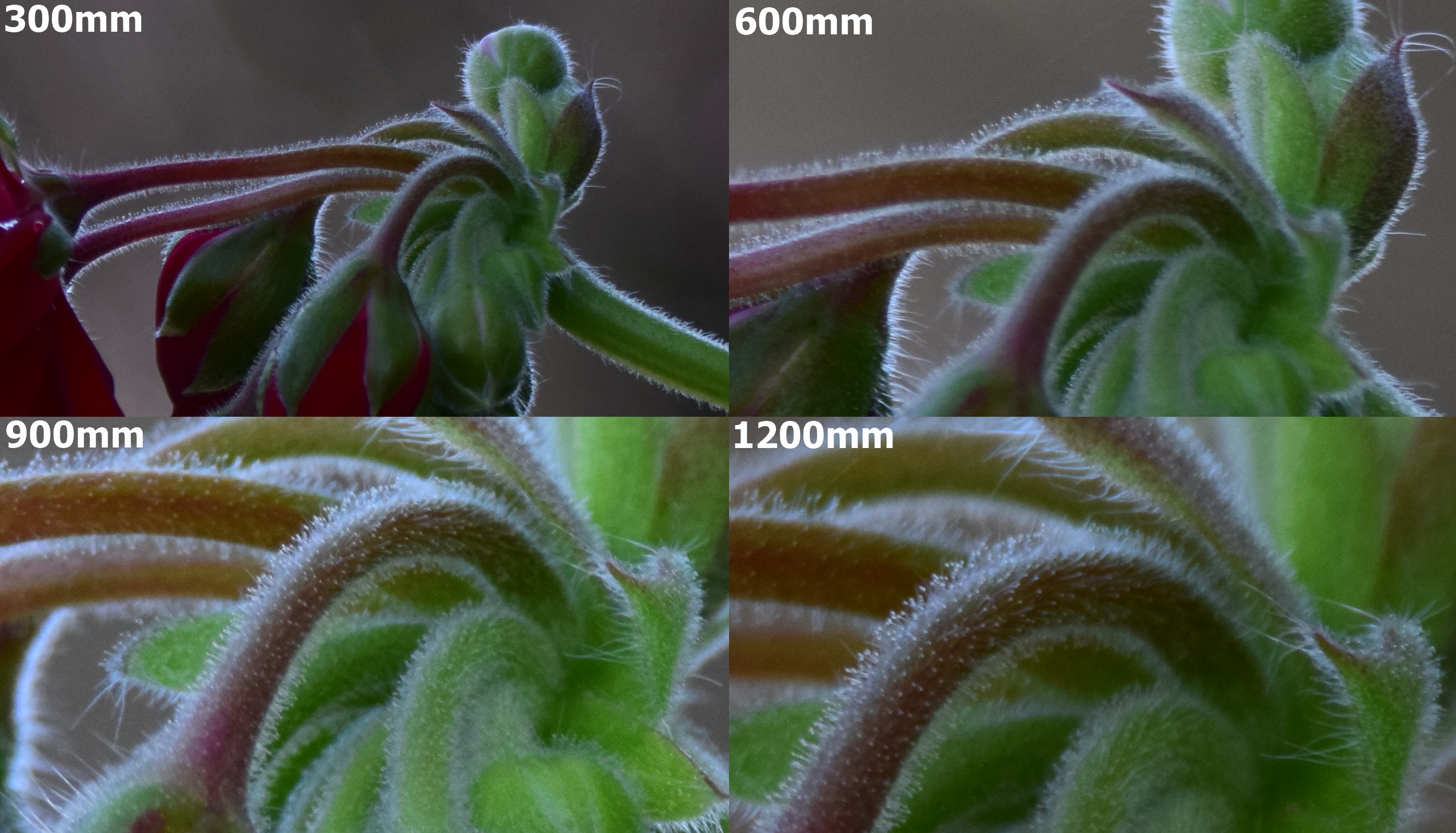
Pic. 47, 48 The minimum distance shots at Sigma teleconverter TC-2001 mounted to Sigma 150-600mm f/5 – 6.3 Contemporary lens, where 47 – normal; 48 – cropped. Szczepańcowa, Poland. Click to enlarge.
As you can see above, the sharpness is really good. Only small astigmatism is visible. You can use this configuration (Sigma 150-600mm f/5- 6.3 Contemporary + teleconverter 2x TC-2001) for a close-up view without hesitation.
9. SUMMARY & EXAMPLE IMAGES
I am in the position of not decided person right now regarding the recommendation of the Sigma teleconverter 2x TC-2001. I cannot recommend this item definitely, because these disadvantages raised here are significant. On the other hand, all users of the TC-2001 can find some way to get images acceptable. We all must know, that the 1200mm focal length is demanding. We can take sharp images at this magnification when our tripod is poor or not stabilized enough. Another thing, that comes out, especially for long-distance observation purposes in the air, is constantly in motion. It also degrades image quality. Concluding, the spectrum of conditions giving the possibility of a perfectly sharp image at 1200mm focal length is very narrow. At this focal length, a lot of problems come out, which are simply hidden, when the shorter lens is used. Regardless of them, the teleconverter 2x TC-2001 combined with Sigma 150-600mm f/5 – 6.3 DG OS HSM Contemporary brings some serious flaws. Unfortunately the most important from our point of view – the image resolution and sharpness might remain sometimes unacceptable, especially at the longest focal length. When sharpness is poor, then every other pro is not important that much. We need our image sharp first before we start to enjoy the possibility of panoramic views etc. The worst thing in the TC-2001 is, that along with not the best sharpness, a significant chromatic aberration appears. This is the biggest chromatic aberration observed throughout the whole kit tested (Sigma 150-600mm Contemporary, TC-1401, and TC-2001). The last thing – astigmatism seems to be also too big. The combination of these 3 things might make our images more often unacceptable. It’s fair enough, comparing at least to the teleconverter 1.4x TC-1401, which performed much better. Possibly from here, the small price difference comes from. The TC-2001 is only 50GBP more expensive than the TC-1401.
I don’t want to be in the position to nullify this teleconverter. Much better sharpness gained from the image captured at the nearest distance leads to the assumption, that maybe some other factor contributes to the line of sight. As I said previously, the air is constantly in motion. The movement of the air and heat can seriously degrade the image. If you want to be convinced, watch the video below.
This teleconverter is definitely a perfect fit for bird watchers and people aimed at things to be photographed from a small distance. For long-distance observations, further investigation is required in terms of the various atmospherical conditions possible to occur at the line of sight. It will be definitely explained in the future.
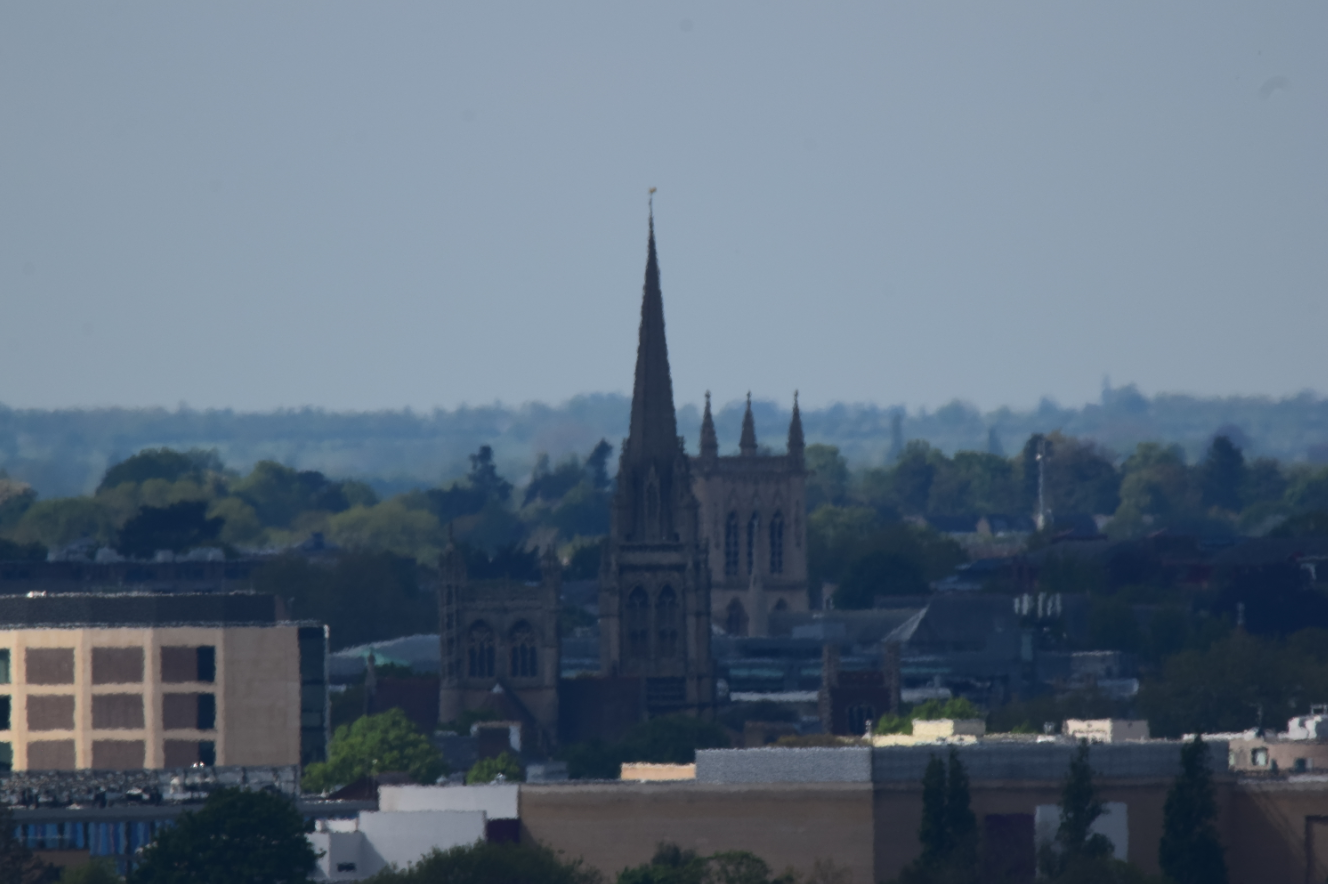
Pic. 49 The Our Lady and English Martyrs Church (OLEM) is seen at a 6km distance and St. John’s College Chapel is possible to see at a 7,5km distance from the Magog Hills above Cambridge, UK. Exif: 1200mm, 1/500s, f/13, ISO 360.

Pic. 50 The phone transmitter is seen from Waterbeach Recreation Ground at about 2km distance. Exif: 1200mm, 1/640s, f/13, ISO 1000.
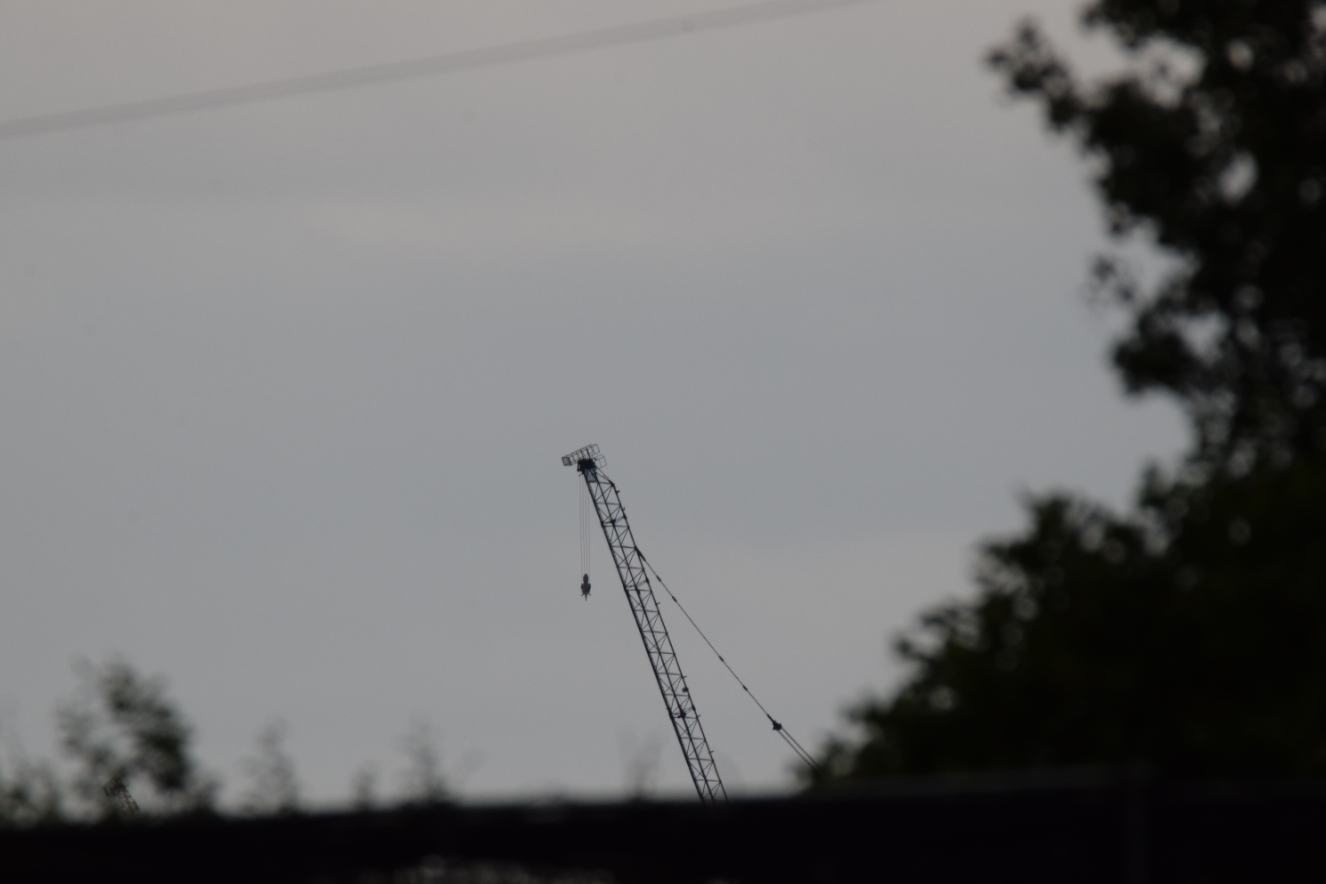
Pic. 51 View at the crane standing in the Cambridge Business Park at a 4,5km distance. Exif: 1200mm, 1/64s, f/13, ISO 1000.
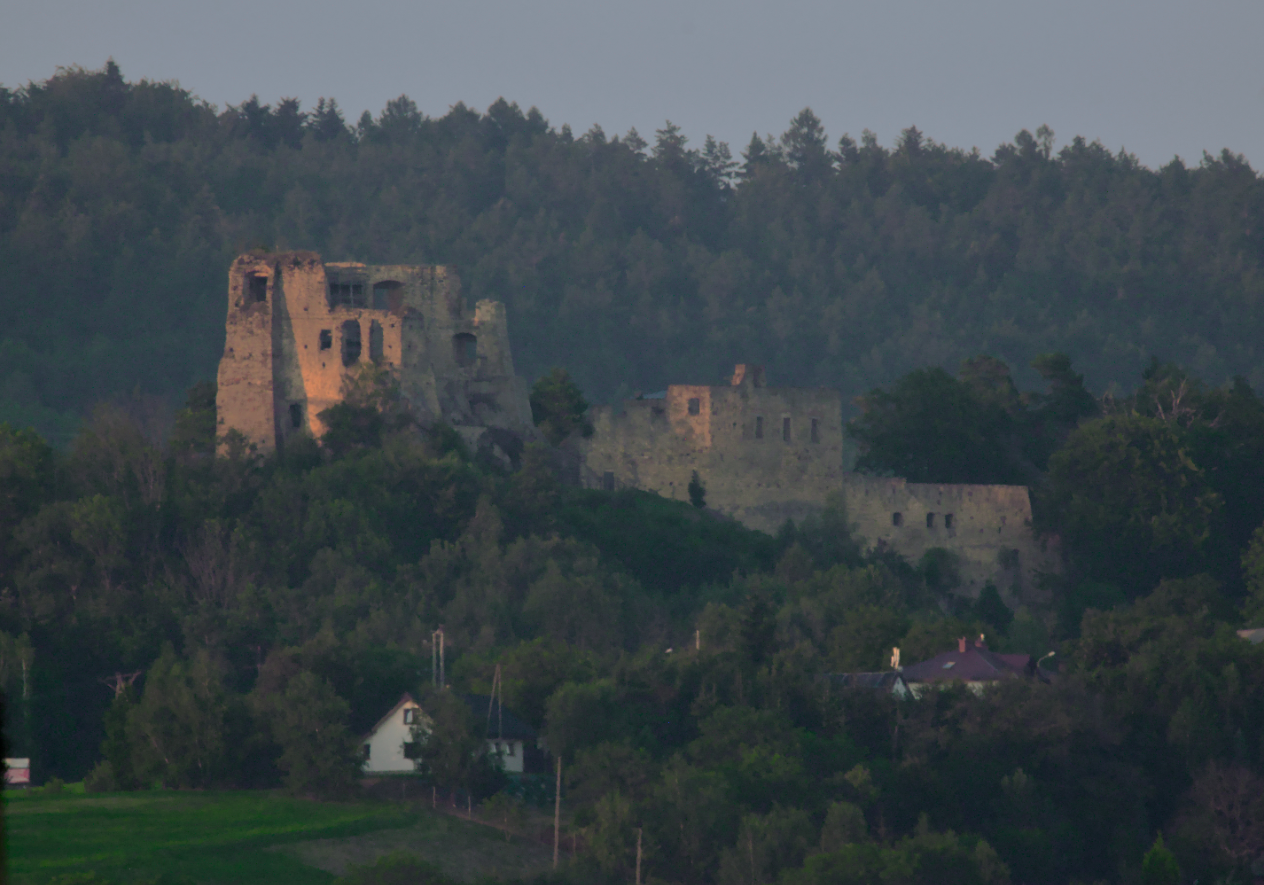
Pic. 52 The “Kamieniec” castle in Odrzykoń seen from Sportowa street in Krosno – Turaszówka at about 5,3km distance. Exif: 1200mm, 1/125s, f/13, ISO 900.
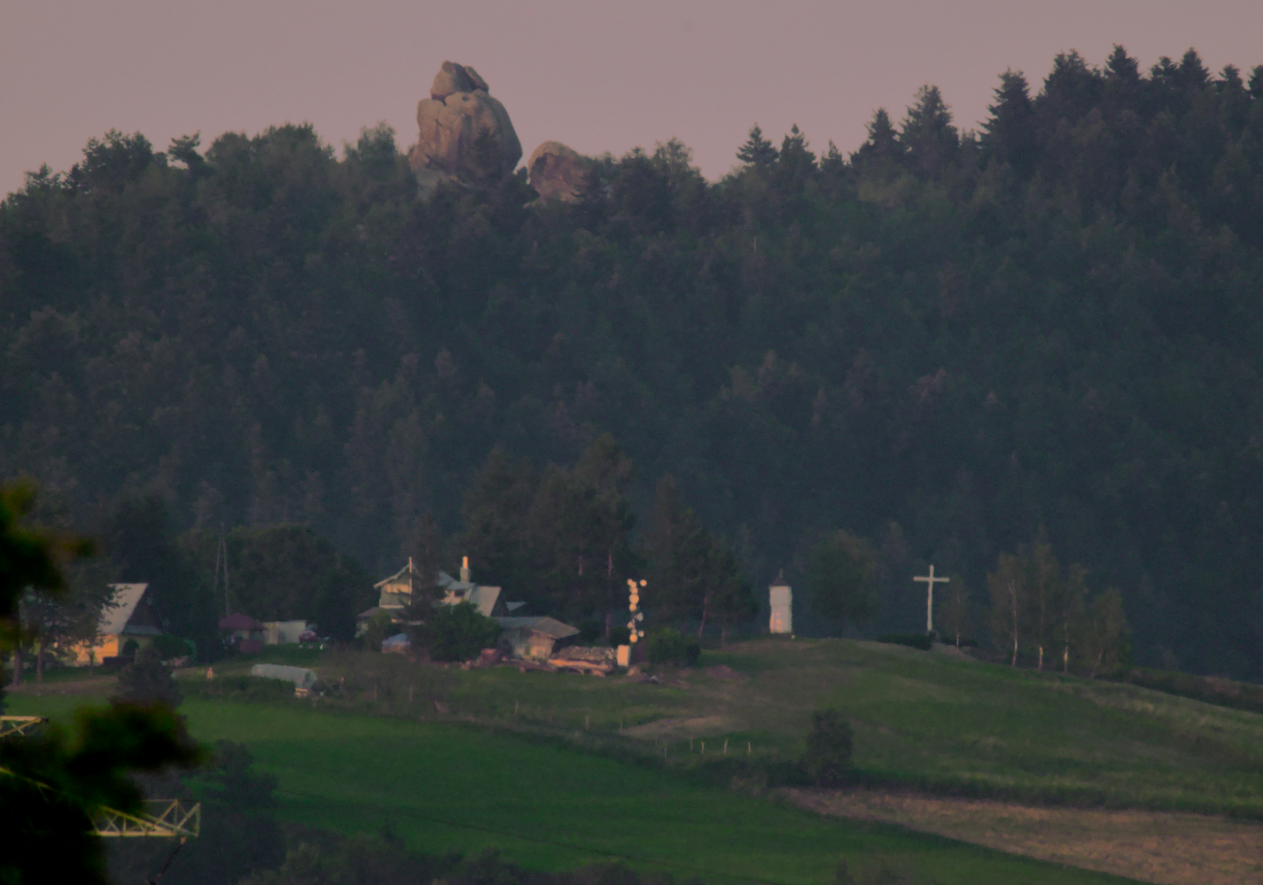
Pic. 53 View at the “Prządki” nature reserve from Sportowa Street in Krosno – Turaszówka at about 6,4km distance. Exif: 1200mm, 1/125s, f/13, ISO 1000.

Pic. 54 The Stanislaus of Szczepanów church in Zręcin seen from Szczepańcowa at a 1,75km distance. Exif: 850mm, f/12, 1/125s, ISO 1600.
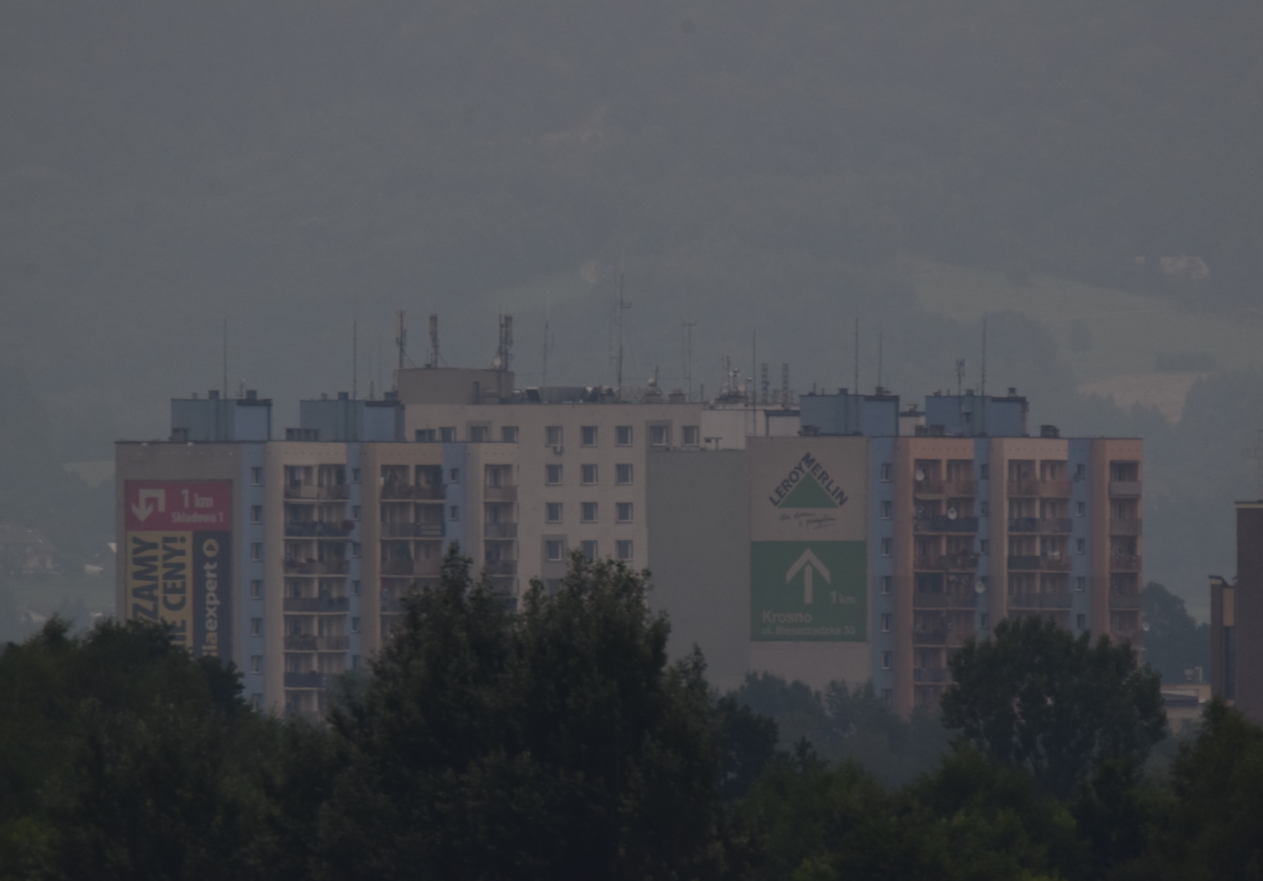
Pic. 55 View at blocks of flats at Piastowska Street in Krosno from Saint Rozalia Street in Szczepańcowa. Distance – 4,3km. Exif: 1000mm,1/125s, f/12, ISO 720.
Mariusz Krukar
Links:
- Why You Should Avoid Shooting at Small Apertures Like F18 to F40
- Over the Moon – story about the TC-2001 images combined with Sigma 150-600 C not sharp enough
- Field Tests: Nikon’s Series III Teleconverters
- Diffraction at small apertures
- https://digital-photography-school.com/why-avoid-shooting-small-apertures-like-f18-f40/
- How to Maximize Image Quality in Photography
- https://www.imaging-resource.com/lenses/sigma/2x-tc-2001/review/
- https://photographylife.com/reviews/sigma-2-0x-teleconverter
- https://www.cameraelectronic.com.au/sigma-tc-2001-2x-teleconverter-for-nikon-f
- First Shoot with Sigma TC-2001 2x paired with Sigma 120-300mm ƒ/2.8 DG OS HSM | S
- https://www.kenrockwell.com/nikon/tc20e.htm
- https://www.sigma-imaging-uk.com/product/teleconverter-apo-tc-2001/
- https://www.sigmaphoto.com/article/sigma-corporation-announces-state-of-the-art-teleconverters-and-filters
Forums:
- https://photo.stackexchange.com/questions/13717/how-do-i-convert-lens-focal-length-mm-to-x-times-optical-zoom
- Sigma 150-600 C + new Sigma 2x extender = not very sharp?
- Part 4 of Sigma 150-600 S Review: Performance with Sigma 1401 and 2001 Teleconverters
- TC-1401 or TC-2001 with Sigma 150-600mm C
Wiki:


